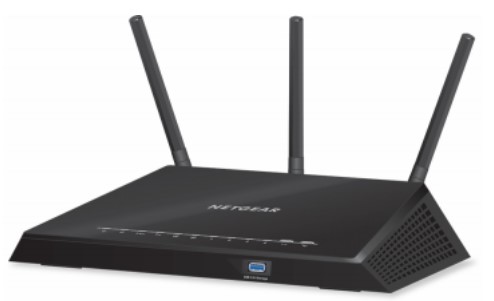You can download the PDF version of the NetGear AC1750 Smart Wifi Router R6400 user manual here
AC1750 Smart WiFi Router
Thank you for selecting NETGEAR products.
After installing your device, locate the serial number on the label of your product and use it to register your product at https://my.netgear.com. You must register your product before you can use NETGEAR telephone support. NETGEAR recommends registering your product through the NETGEAR website. For product updates and web support, visit http://support.netgear.com.
Phone (US & Canada only): 1-888-NETGEAR.
Phone (Other Countries): Check the list of phone numbers at http://support.netgear.com/general/contact/default.aspx.
Trademarks
© NETGEAR, Inc., NETGEAR and the NETGEAR Logo are trademarks of NETGEAR, Inc. Any non-NETGEAR trademarks are used for reference purposes only.
Compliance
For regulatory compliance information, visit http://www.netgear.com/about/regulatory/.
See the regulatory compliance document before connecting the power supply.
1. Hardware Setup
The AC1750 Smart WiFi Router delivers extremely fast WiFi. With AC1750 WiFi, Gigabit Ethernet speeds, and high-powered external antennas, this router offers the ultimate performance in wireless coverage for large homes with 12 or more wireless devices.
The router provides fast central storage, backup, and streaming to every device in your home with the USB 3.0-Storage port (10 times faster than USB 2.0). Sharing content across your network is easy, whether it’s accessing stored photos and music to wirelessly printing. Stream your stored media files anywhere on the network to DLNA screens. Share your music to Airplay-compatible devices from the USB hard-drive connected to the router. Use the free NETGEAR ReadySHARE Vault app to back up your Windows computers to a connect USB hard drive.
This chapter contains the following sections:
• Unpack Your Router
• Extend the Antennas
• Top and Front Panels
• Rear Panel
• Position Your Router
• Cable Your Router
For more information about the topics covered in this manual, visit the support website at support.netgear.com.
Unpack Your Router
Your package contains the following items.
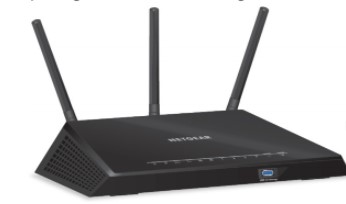


Figure 1. Package contents
Extend the Antennas
The router comes with three antennas.
⮚ To extend the antennas:
Position the antennas for the best WiFi performance.
NETGEAR recommends that the center antenna be vertical and that you aim the others outward at 45-degree angles as shown.
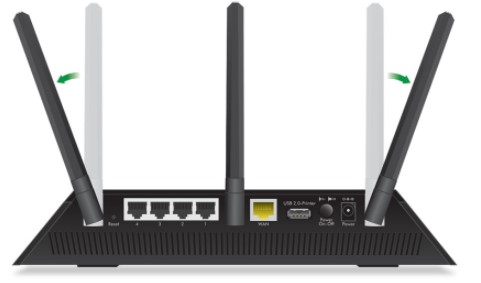
Top And Front Panels
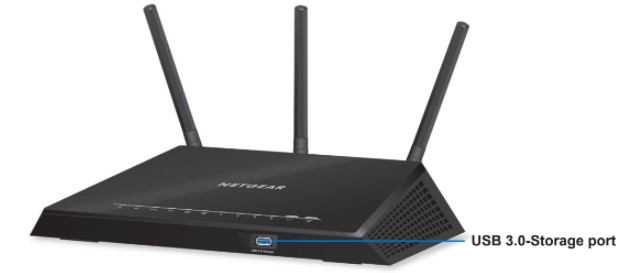
Figure 2. Router top and front view
Table 1. LED and button descriptions
| LED | Description |
| Power | • Solid amber. The router is starting. • Blinking amber. The firmware is upgrading, or the Reset button was pressed. •Solid white. The router is ready. • Blinking white. The firmware is corrupted. •Off. Power is not supplied to the router. |
| Internet | • Solid white. The Internet connection is ready. • Solid amber. The router detected an Ethernet cable connection to the modem. • Off. No Ethernet cable is connected between the router and the modem. |
| 2.4 GHz WiFi | • Solid white. The 2.4 GHz WiFi radio is operating. • Blinking. The router is sending or receiving WiFi traffic. • Off. The 2.4 GHz WiFi radio is off. |
| 5 GHz WiFi | • Solid white. The 5 GHz WiFi radio is operating. • Blinking. The router is sending or receiving WiFi traffic. • Off. The 5 GHz WiFi radio is off. |
| USB 3.0-Storage port) | • Solid white. A USB device is connected and is ready. •Blinking. A USB device is plugged in and is trying to connect. • Off. No USB device is connected, or someone clicked the Safely Remove Hardware button, and it is now safe to remove the attached USB device. |
Table 1. LED and button descriptions (continued)
AC1750 Smart WiFi Router
| LED | Description |
| USB 2.0-Printer port | • Solid white. A USB device is connected and is ready. • Blinking. A USB device is plugged in and is trying to connect. • Off. No USB device is connected or someone clicked the Safely Remove Hardware button and it is now safe to remove the attached USB device. |
| Ethernet ports 1–4 | The LED color indicates the speed: white for Gigabit Ethernet connections and amber for 100 Mbps or 10 Mbps Ethernet connections. • Solid. A powered-on device is connected to the Ethernet port. • Blinking. The port is sending or receiving traffic. • Off. No device is connected to this Ethernet port. |
| WiFi On/Off button with LED | Pressing this button for two seconds turns the 2.4 GHz and 5 GHz WiFi radios on and off. If this LED is lit, the WiFi radios are on. If this LED is off, the WiFi radios are turned off and you cannot use WiFi to connect to the router. |
| WPS button with LED | This button lets you use WPS to join the WiFi network without typing the WiFi password. The WPS LED blinks white during this process and then lights solid white. |
You can disable LED blinking or turn off all LEDs except the Power LED. For information about how to do this, see Disable LED Blinking or Turn Off LEDs on page 107.
Rear Panel
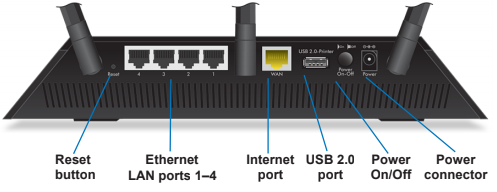
Figure 3. Router rear panel
Pressing the Reset button restores the factory settings. See Factory Settings on page 178.
Position Your Router
The router lets you access your network anywhere within the operating range of your wireless network. However, the operating distance or range of your wireless connection can vary significantly depending on the physical placement of your router. For example, the thickness and number of walls the wireless signal passes through can limit the range.
Additionally, other wireless access points in and around your home might affect your router’s signal. Wireless access points are routers, repeaters, WiFi range extenders, or any other device that emits a wireless signal for network access.
Position your router according to the following guidelines:
• Place your router near the center of the area where your computers and other devices operate, and within line of sight to your wireless devices.
• Make sure that the router is within reach of an AC power outlet and near Ethernet cables for wired computers.
• Place the router in an elevated location, minimizing the number walls and ceilings between the router and your other devices.
• Place the router away from electrical devices such as these:
– Ceiling fans
– Home security systems
– Microwaves
– Computers
– Base of a cordless phone
– 2.4 GHz cordless phone
• Place the router away from large metal surfaces, large glass surfaces, and insulated walls such as these:
– Solid metal door
– Aluminum studs
– Fish tanks
– Mirrors
– Brick
– Concrete
If your network includes adjacent access points, use different radio frequency channels to reduce interference.
Cable Your Router
The following image shows how to cable your router:
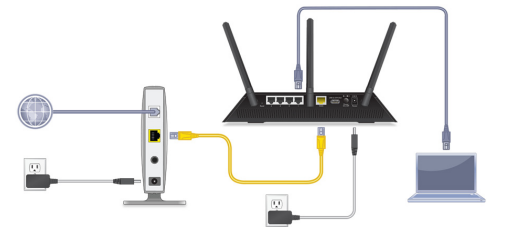
⮚ To cable your router:
1. Unplug your modem’s power, leaving the modem connected to the wall jack for your Internet service.
If your modem uses a battery backup, remove the battery.
2. Plug in and turn on your modem.
If your modem uses a battery backup, replace the battery.
3. Connect your modem to the Internet port of your router with the yellow Ethernet cable that came with your router.
4. Connect the power adapter to your router and plug the power adapter into an outlet. 5. Press the Power On/Off button on the rear panel of the router.
2. Connect to the Network and Access the Router
This chapter contains the following sections:
• Connect to the Network
• Types of Logins
• Use an Internet Browser to Access the Router
• Change the Language
• Access the Router with the NETGEAR genie App
Connect to the Network
You can connect to the router’s network through a wired or WiFi connection. If you set up your computer to use a static IP address, change the settings so that it uses Dynamic Host Configuration Protocol (DHCP).
Wired Connection
You can connect your computer to the router using an Ethernet cable and join the router’s local area network (LAN).
⮚ To connect your computer to the router with an Ethernet cable:
1. Make sure that the router is receiving power (its Power LED is lit).
2. Connect an Ethernet cable to an Ethernet port on your computer.
3. Connect the other end of the Ethernet cable to one of the numbered Ethernet ports.
Your computer connects to the local area network (LAN). A message might display on your computer screen to notify you that an Ethernet cable is connected.
WiFi Connection
You can connect to the router’s WiFi network with Wi-Fi Protected Setup (WPS) or you can find and select the WiFi network.
⮚ To use WPS to connect to the WiFi network:
1. Make sure that the router is receiving power (its Power LED is lit).
2. Check the WPS instructions for your computer or wireless device.
3. Press the WPS button on the router.
4. Within two minutes, on your computer or WiFi device, press its WPS button or follow its instructions for WPS connections.
Your computer or wireless device connects to the WiFi network.
⮚ To find and select the WiFi network:
1. Make sure that the router is receiving power (its Power LED is lit).
2. On your computer or wireless device, find and select the WiFi network. The WiFi network name is on the router’s label.
3. Join the WiFi network and enter the WiFi password.
The password is on the router’s label.
Your wireless device connects to the WiFi network.
Connect to the Network and Access the Router
Label
The label on the router shows the login information, MAC address, and serial number.

Figure 5. Router label
Types of Logins
Separate types of logins serve different purposes. It is important that you understand the difference so that you know which login to use when.
Types of logins:
• ISP login. The login that your ISP gave you logs you in to your Internet service. Your service provider gave you this login information in a letter or some other way. If you cannot find this login information, contact your service provider.
• WiFi network key or password. Your router is preset with a unique wireless network name (SSID) and password for wireless access. This information is on the router label.
• Router login. This logs you in to the router interface as admin from an Internet browser.
Use An Internet Browser to Access the Router
When you connect to the network (either with WiFi or with an Ethernet cable), you can use an Internet browser to access the router to view or change its settings. The first time you access the router, NETGEAR genie automatically checks to see if your router can connect to your Internet service.
NETGEAR genie Automatic Internet Setup
You can set up your router with the NETGEAR genie automatically, or you can use the genie menus and pages to set up your router manually. Before you start the setup process, get your ISP information and make sure that the computers and devices in the network use the settings described here.
When your Internet service starts, your Internet service provider (ISP) typically gives you all the information needed to connect to the Internet. For DSL service, you might need the following information to set up your router:
• The ISP configuration information for your DSL account
• ISP login name and password
• Fixed or static IP address settings (special deployment by ISP; this setting is rare)
If you cannot locate this information, ask your ISP to provide it. When your Internet connection is working, you no longer need to launch the ISP login program on your computer to access the Internet. When you start an Internet application, your router automatically logs you in.
NETGEAR genie runs on any device with a web browser. Installation and basic setup takes about 15 minutes to complete.
⮚ To use NETGEAR genie to set up your router:
1. Turn the router on by pressing the On/Off button.
2. Make sure that your computer or wireless device is connected to the router with an Ethernet cable (wired) or wirelessly with the preset security settings listed on the label.
Note: If you want to change the router’s WiFi settings, use a wired connection to avoid being disconnected when the new WiFi settings take effect.
3. Launch an Internet browser.
The page that displays depends on whether you accessed the router before or if NETGEAR genie detects that the router is connected to another router or gateway:
• The first time that you set up the Internet connection for your router, the browser goes to http://www.routerlogin.net, and the NETGEAR genie page displays.
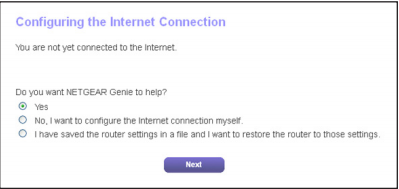
• If NETGEAR genie detects that the router is connected to another router or gateway, NETGEAR genie prompts you to set up the router in router mode or access point mode:

Select the Help Me Choose radio button or Let Me Choose radio button:
– Help Me Choose. If you select the Help Me Choose radio button, NETGEAR genie asks you a few questions to determine if you should set the router in router mode or access point mode. NETGEAR recommends that you select the Help Me Choose radio button.
– Let Me Choose. If you select the Let Me Choose radio button, you must select the Router Mode radio button or the Access Point Mode radio button. You can change the mode by running the Setup Wizard again. For more information, see Use the Internet Setup Wizard on page 22.
For more information about how to set up your router with an existing router or gateway, see Set Up the Router with an Existing Router or Gateway on page 126.
• If you already used the NETGEAR genie, type http://www.routerlogin.net in the address field for your browser to display the NETGEAR genie page.
4. Follow the onscreen instructions.
NETGEAR genie guides you through connecting the router to the Internet.
5. If the browser cannot display the web page, do the following:
• Make sure that the computer is connected to one of the four LAN Ethernet ports or wirelessly to the router.
• Make sure that the router is receiving full power, and that its Power LED is lit white. • Close and reopen the browser or clear the browser cache.
• Browse to http://www.routerlogin.net.
• If the computer is set to a static or fixed IP address (this setting is uncommon), change it to obtain an IP address automatically from the router.
6. If the router does not connect to the Internet, do the following:
a. Review your settings.
Make sure that you selected the correct options and typed everything correctly.
b. Contact your ISP to verify the correct configuration information.
c. Read Chapter 14, Troubleshooting.
If problems persist, register your NETGEAR product and contact NETGEAR technical support.
Log In to the Router
When you first set up your router, NETGEAR genie automatically starts when you launch an Internet browser on a computer that is connected to the router. If you want to view or change settings for the router, you can use genie again.
⮚ To log in to the router:
1. Launch an Internet browser from a computer or wireless device that is connected to the network.
2. Type http://www.routerlogin.net or http://www.routerlogin.com.
A login window opens.
3. Enter the router user name and password.
The user name is admin. The default password is password. The user name and password are case-sensitive.
The BASIC Home page displays.
Change the Language
By default, the language is set as Auto.
⮚ To change the language:
1. Launch an Internet browser from a computer or wireless device that is connected to the network.
2. Type http://www.routerlogin.net or http://www.routerlogin.com.
A login window opens.
3. Enter the router user name and password.
The user name is admin. The default password is password. The user name and password are case-sensitive.
The BASIC Home page displays.
4. In the upper right corner, select a language from the menu.
5. When prompted, click the OK button to confirm this change.
The page refreshes with the language that you selected.
Access the Router with the NETGEAR genie App
The genie app is the easy dashboard for managing, monitoring, and repairing your home network. The genie app can help you with the following:
• Automatically repair common wireless network problems.
• Easily manage router features like Parental Controls, guest access, Internet traffic meter, speed test, and more.
⮚ To use the genie app to access the router:
1. Visit the NETGEAR genie web page at www.NETGEAR.com/genie.
2. Follow the onscreen instructions to install the app on your smartphone, tablet, or computer.
3. Launch the genie app.
The genie app dashboard page displays.
3. specify Your Internet Settings
Usually, the quickest way to set up the router to use your Internet connection is to allow the genie to detect the Internet connection when you first access the router with an Internet browser. You can also customize or specify your Internet settings.
This chapter contains the following sections:
• Use the Internet Setup Wizard
• Manually Set Up the Internet Connection
• Specify IPv6 Internet Connections
• Change the MTU Size
• Enable the Bridge or Add a VLAN Tag Group
Use the Internet Setup Wizard
You can use the Setup Wizard to detect your Internet settings and automatically set up your router. The Setup Wizard is not the same as the genie pages that display the first time you connect to your router to set it up.
⮚ To use the Setup Wizard:
1. Launch an Internet browser from a computer or wireless device that is connected to the network.
2. Type http://www.routerlogin.net or http://www.routerlogin.com.
A login window opens.
3. Enter the router user name and password.
The user name is admin. The default password is password. The user name and password are case-sensitive.
The BASIC Home page displays.
4. Select ADVANCED > Setup Wizard.
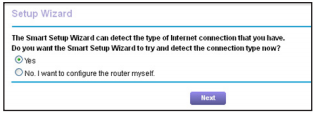
5. Select the Yes radio button.
If you select the No radio button, you are taken to the Internet Setup page (see Manually Set Up the Internet Connection ).
6. Click the Next button.
The Setup Wizard searches your Internet connection for servers and protocols to determine your ISP configuration and checks your operation mode.
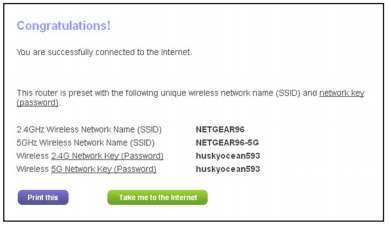
Manually Set Up the Internet Connection
You can view or change the router’s Internet connection settings.
Specify an Internet Connection That Does Not Use a Login
⮚ To specify the Internet connection settings:
1. Launch an Internet browser from a computer or wireless device that is connected to the network.
2. Type http://www.routerlogin.net or http://www.routerlogin.com.
A login window opens.
3. Enter the router user name and password.
The user name is admin. The default password is password. The user name and password are case-sensitive.
The BASIC Home page displays.
4. Select Internet.
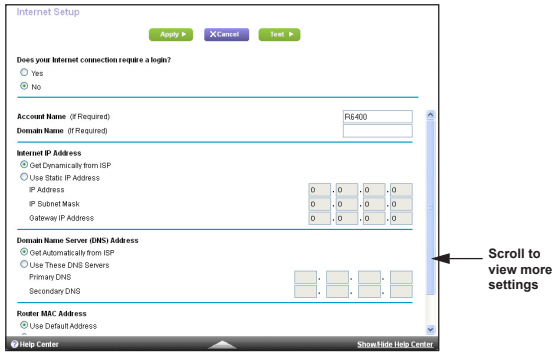
5. For the Does your Internet connection require a login setting, leave the No radio button selected.
6. If your Internet connection requires an account name or host name, type it in the Account Name (If Required) field.
7. If your Internet connection requires a domain name, type it in the Domain Name (If Required) field.
For the other sections in this page, the default settings usually work, but you can change them.
8. Select an Internet IP Address radio button:
• Get Dynamically from ISP. Your ISP uses DHCP to assign your IP address. Your ISP automatically assigns these addresses.
• Use Static IP Address. Enter the IP address, IP subnet mask, and the gateway IP address that your ISP assigned. The gateway is the ISP router to which your router connects.
9. Select a Domain Name Server (DNS) Address radio button:
• Get Automatically from ISP. Your ISP uses DHCP to assign your DNS servers. Your ISP automatically assigns this address.
• Use These DNS Servers. If you know that your ISP requires specific servers, select this option. Enter the IP address of your ISP’s primary DNS server. If a secondary DNS server address is available, enter it also.
10. Select a Router MAC Address radio button:
• Use Default Address. Use the default MAC address.
• Use Computer MAC Address. The router captures and uses the MAC address of the computer that you are now using. You must use the one computer that the ISP allows.
• Use This MAC Address. Enter the MAC address that you want to use.
11. Click the Apply button.
Your settings are saved.
12. Click the Test button to test your Internet connection.
If the NETGEAR website does not display within one minute, see Chapter 14, Troubleshooting.
Specify an Internet Connection That Uses a Login
⮚ To view or change the basic Internet setup:
1. Launch an Internet browser from a computer or wireless device that is connected to the network.
2. Type http://www.routerlogin.net or http://www.routerlogin.com.
A login window opens.
3. Enter the router user name and password.
The user name is admin. The default password is password. The user name and password are case-sensitive.
The BASIC Home page displays.
4. Select Internet.
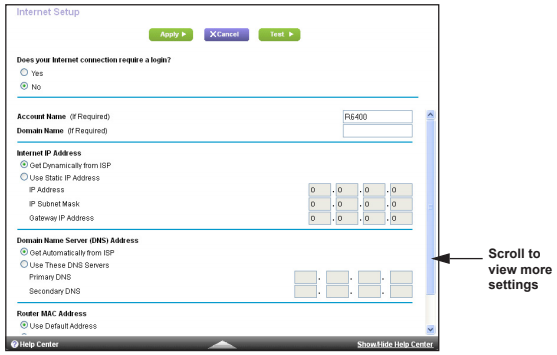
5. For the Does your Internet connection require a login setting, select the Yes radio button. The page adjusts.
6. In the Internet Service Provider menu, select the encapsulation method PPPoE, PPTP, or L2TP.
7. In the Login field, enter the login name your ISP gave you.
This login name is often an email address.
8. In the Password field, type the password that you use to log in to your Internet service.
9. If your ISP requires a service name, type it in the Service Name (if Required) field.
10. In the Connection Mode menu, select Always On, Dial on Demand, or Manually Connect.
11. To change the number of minutes until the Internet login time-out, in the Idle Timeout (In minutes) field, type the number of minutes.
This is how long the router keeps the Internet connection active when no one on the network is using the Internet connection. A value of 0 (zero) means never log out.
12. Select an Internet IP Address radio button:
• Get Dynamically from ISP. Your ISP uses DHCP to assign your IP address. Your ISP automatically assigns these addresses.
• Use Static IP Address. Enter the IP address, IP subnet mask, and the gateway IP address that your ISP assigned. The gateway is the ISP router to which your router connects.
13. Select a Domain Name Server (DNS) Address radio button:
• Get Automatically from ISP. Your ISP uses DHCP to assign your DNS servers. Your ISP automatically assigns this address.
• Use These DNS Servers. If you know that your ISP requires specific servers, select this option. Enter the IP address of your ISP’s primary DNS server. If a secondary DNS server address is available, enter it also.
14. Select a Router MAC Address radio button:
• Use Default Address. Use the default MAC address.
• Use Computer MAC Address. The router captures and uses the MAC address of the computer that you are now using. You must use the one computer that the ISP allows.
• Use This MAC Address. Enter the MAC address that you want to use.
15. Click the Apply button.
Your settings are saved.
16. Click the Test button to test your Internet connection.
If the NETGEAR website does not display within one minute, see Chapter 14, Troubleshooting.
Specify IPv6 Internet Connections
You can set up an IPv6 Internet connection if genie does not detect it automatically.
⮚ To set up an IPv6 Internet connection:
1. Launch an Internet browser from a computer or wireless device that is connected to the network.
2. Type http://www.routerlogin.net or http://www.routerlogin.com..
A login window opens.
3. Enter the router user name and password.
The user name is admin. The default password is password. The user name and password are case-sensitive.
The BASIC Home page displays.
4. Select ADVANCED > Advanced Setup > IPv6.
The IPv6 page displays.
5. In the Internet Connection Type menu, select the IPv6 connection type. Your Internet service provider (ISP) can provide this information.
• If your ISP did not provide details, select IPv6 Tunnel.
• If you are not sure, select Auto Detect so that the router detects the IPv6 type that is in use.
• If your Internet connection does not use PPPoE or DHCP or is not fixed, but is IPv6, select Auto Config.
Your Internet service provider (ISP) can provide this information. For more information about IPv6 Internet connection, see the following sections:
– Use Auto Detect for an IPv6 Internet Connection on page 28
– Use Auto Config for an IPV6 Internet Connection on page 29
– Set Up an IPv6 6rd Tunnel Internet Connection on page 31
– Set Up an IPv6 6to4 Tunnel Internet Connection on page 33
– Set Up an IPv6 Pass Through Internet Connection on page 35
– Set Up an IPv6 Fixed Internet Connection on page 35
– Set Up an IPv6 DHCP Internet Connection on page 37
– Set Up an IPv6 PPPoE Internet Connection on page 38
6. Click the Apply button.
Your changes take effect.
Requirements for Entering IPv6 Addresses
IPv6 addresses are denoted by eight groups of hexadecimal quartets that are separated by colons. You can reduce any four-digit group of zeros within an IPv6 address to a single zero or omit it. The following errors invalidate an IPv6 address:
• More than eight groups of hexadecimal quartets
• More than four hexadecimal characters in a quartet
• More than two colons in a row
Use Auto Detect for an IPv6 Internet Connection
⮚ To set up an IPv6 Internet connection through auto detection:
1. Launch an Internet browser from a computer or wireless device that is connected to the network.
2. Type http://www.routerlogin.net or http://www.routerlogin.com.
A login window opens.
3. Enter the router user name and password.
The user name is admin. The default password is password. The user name and password are case-sensitive.
The BASIC Home page displays.
4. Select ADVANCED > Advanced Setup > IPv6.
The IPv6 page displays.
5. In the Internet Connection Type menu, select Auto Detect.
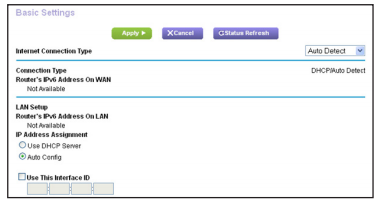
The router automatically detects the information in the following fields:
• Connection Type. This field indicates the connection type that is detected.
• Router’s IPv6 Address on WAN. This field shows the IPv6 address that is acquired for the router’s WAN (or Internet) interface. The number after the slash (/) is the length of the prefix, which is also indicated by the underline (_) under the IPv6 address. If no address is acquired, the field displays Not Available.
• Router’s IPv6 Address on LAN. This field shows the IPv6 address that is acquired for the router’s LAN interface. The number after the slash (/) is the length of the prefix, which is also indicated by the underline (_) under the IPv6 address. If no address is acquired, the field displays Not Available.
6. Select an IP Address Assignment radio button:
• Use DHCP Server. This method passes more information to LAN devices, but some IPv6 systems might not support the DHCv6 client function.
• Auto Config. This is the default setting.
This setting specifies how the router assigns IPv6 addresses to the devices on your home network (the LAN).
7. (Optional) Select the Use This Interface ID check box and specify the interface ID to be used for the IPv6 address of the router’s LAN interface.
If you do not specify an ID here, the router generates one automatically from its MAC address.
8. Click the Apply button.
Your settings are saved.
Use Auto Config for an IPV6 Internet Connection
⮚ To set up an IPv6 Internet connection through auto configuration:
1. Launch an Internet browser from a computer or wireless device that is connected to the network.
2. Type http://www.routerlogin.net or http://www.routerlogin.com.
A login window opens.
3. Enter the router user name and password.
The user name is admin. The default password is password. The user name and password are case-sensitive.
The BASIC Home page displays.
4. Select ADVANCED > Advanced Setup > IPv6.
The IPv6 page displays.
5. In the Internet Connection Type menu, select Auto Config.
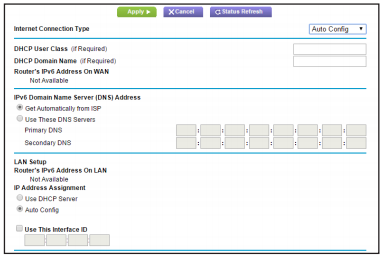
The router automatically detects the information in the following fields:
• Router’s IPv6 Address on WAN. This field shows the IPv6 address that is acquired for the router’s WAN (or Internet) interface. The number after the slash (/) is the length of the prefix, which is also indicated by the underline (_) under the IPv6 address. If no address is acquired, the field displays Not Available.
• Router’s IPv6 Address on LAN. This field shows the IPv6 address that is acquired for the router’s LAN interface. The number after the slash (/) is the length of the prefix, which is also indicated by the underline (_) under the IPv6 address. If no address is acquired, the field displays Not Available.
6. Select an IPv6 Domain Name Server (DNS) Address radio button:
• Get Automatically from ISP. Your ISP uses DHCP to assign your DNS servers. Your ISP automatically assigns this address.
• Use These DNS Servers. If you know that your ISP requires specific servers, select this option. Enter the IP address of your ISP’s primary DNS server. If a secondary DNS server address is available, enter it also.
7. (Optional) In the DHCP User Class (If Required) field, enter a host name.
Most people can leave this field blank, but if your ISP gave you a specific host name, enter it here.
8. (Optional) In the DHCP Domain Name (If Required) field, enter a domain name.
You can type the domain name of your IPv6 ISP. Do not enter the domain name for the IPv4 ISP here. For example, if your ISP’s mail server is mail.xxx.yyy.zzz, type xxx.yyy.zzz as the domain name. If your ISP provided a domain name, type it in this field. For example, Earthlink Cable might require a host name of home, and Comcast sometimes supplies a domain name.
9. Select an IP Address Assignment radio button:
• Use DHCP Server. This method passes more information to LAN devices, but some IPv6 systems might not support the DHCv6 client function.
• Auto Config. This is the default setting.
This setting specifies how the router assigns IPv6 addresses to the devices on your home network (the LAN).
10. (Optional) Select the Use This Interface ID check box and specify the interface ID that you want to be used for the IPv6 address of the router’s LAN interface.
If you do not specify an ID here, the router generates one automatically from its MAC address.
11. Click the Apply button.
Your settings are saved.
Set Up an IPv6 6rd Tunnel Internet Connection
6rd protocol makes it possible to deploy IPv6 to sites using a service provider’s IPv4 network. 6rd uses the service provider’s own IPv6 address prefix. This limits the operational domain of 6rd to the service provider’s network and is under direct control of the service provider. The IPv6 service provided is equivalent to native IPv6.
The 6rd mechanism relies upon an algorithmic mapping between the IPv6 and IPv4 addresses that are assigned for use within the service provider’s network. This mapping allows for automatic determination of IPv4 tunnel endpoints from IPv6 prefixes, allowing stateless operation of 6rd.
With a 6rd tunnel configuration, the router follows the RFC5969 standard, supporting two ways to establish a 6rd tunnel IPv6 WAN connection:
• Auto Mode. In IPv6 Auto Detect mode, when the router receives option 212 from the DHCPv4 option, auto detect selects the IPv6 as 6rd Tunnel setting. The router uses the 6rd option information to establish the 6rd connection.
• Manual Mode. Select 6rd tunnel. If the router receives option 212, the fields are automatically completed. Otherwise, you must enter the 6rd settings.
⮚ To set up an IPv6 6rd tunnel Internet connection:
1. Launch a web browser from a computer or wireless device that is connected to the network.
2. Type http://www.routerlogin.net or http://www.routerlogin.com.
A login window opens.
3. Enter the router user name and password.
The user name is admin. The default password is password. The user name and password are case-sensitive.
The BASIC Home page displays.
4. Select ADVANCED > Advanced Setup > IPv6.
The IPv6 page displays.
5. In the Internet Connection Type menu, select 6rd Tunnel.
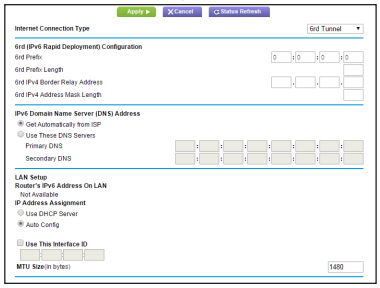
The router automatically detects the information in the following sections:
• 6rd (IPv6 Rapid Development) Configuration. The router detects the service provider’s IPv4 network and attempts to establish an IPv6 6rd tunnel connection. If the IPv4 network returns 6rd parameters to the router, the page adjusts to display the correct settings in this section.
• Router’s IPv6 Address on LAN. This field shows the IPv6 address that is acquired for the router’s LAN interface. The number after the slash (/) is the length of the prefix, which is also indicated by the underline (_) under the IPv6 address. If no address is acquired, the field displays Not Available.
• MTU size (in bytes). The normal MTU (maximum transmit unit) value for most Ethernet networks is 1500 bytes, or 1492 bytes for PPPoE connections. Change the MTU only if you are sure that it is necessary for your ISP connection. See Change the MTU Size on page 40.
6. Select an IPv6 Domain Name Server (DNS) Address radio button:
• Get Automatically from ISP. Your ISP uses DHCP to assign your DNS servers. Your ISP automatically assigns this address.
• Use These DNS Servers. If you know that your ISP requires specific servers, select this option. Enter the IP address of your ISP’s primary DNS server. If a secondary DNS server address is available, enter it also.
7. Select an IP Address Assignment radio button:
• Use DHCP Server. This method passes more information to LAN devices, but some IPv6 systems might not support the DHCv6 client function.
• Auto Config. This is the default setting.
This setting specifies how the router assigns IPv6 addresses to the devices on your home network (the LAN).
8. (Optional) Select the Use This Interface ID check box and specify the interface ID that you want to be used for the IPv6 address of the router’s LAN interface.
If you do not specify an ID here, the router generates one automatically from its MAC address.
9. Click the Apply button.
Your settings are saved.
Set Up an IPv6 6to4 Tunnel Internet Connection
The remote relay router is the router to which your router creates a 6to4 tunnel. Make sure that the IPv4 Internet connection is working before you apply the 6to4 tunnel settings for the IPv6 connection.
⮚ To set up an IPv6 Internet connection by using a 6to4 tunnel:
1. Launch an Internet browser from a computer or wireless device that is connected to the network.
2. Type http://www.routerlogin.net or http://www.routerlogin.com.
A login window opens.
3. Enter the router user name and password.
The user name is admin. The default password is password. The user name and password are case-sensitive.
The BASIC Home page displays.
4. Select ADVANCED > Advanced Setup > IPv6.
The IPv6 page displays.
5. In the Internet Connection Type menu, select 6to4 Tunnel.
The page adjusts:
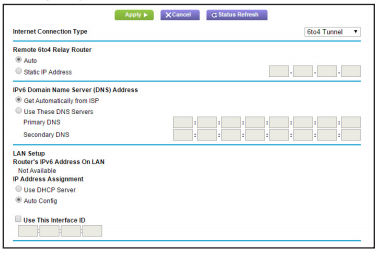
The router automatically detects the information in the Router’s IPv6 Address on LAN field. This field shows the IPv6 address that is acquired for the router’s LAN interface. The number after the slash (/) is the length of the prefix, which is also indicated by the underline (_) under the IPv6 address. If no address is acquired, the field displays Not Available.
6. Select a Remote 6to4 relay Router radio button:
• Auto. Your router uses any remote relay router that is available on the Internet. This is the default setting.
• Static IP Address. Enter the static IPv4 address of the remote relay router. Your IPv6 ISP usually provides this address.
7. Select an IPv6 Domain Name Server (DNS) Address radio button:
• Get Automatically from ISP. Your ISP uses DHCP to assign your DNS servers. Your ISP automatically assigns this address.
• Use These DNS Servers. If you know that your ISP requires specific servers, select this option. Enter the IP address of your ISP’s primary DNS server. If a secondary DNS server address is available, enter it also.
8. Select an IP Address Assignment radio button:
• Use DHCP Server. This method passes more information to LAN devices, but some IPv6 systems might not support the DHCv6 client function.
• Auto Config. This is the default setting.
This setting specifies how the router assigns IPv6 addresses to the devices on your home network (the LAN).
9. (Optional) Select the Use This Interface ID check box and specify the interface ID that you want to be used for the IPv6 address of the router’s LAN interface.
If you do not specify an ID here, the router generates one automatically from its MAC address.
10. Click the Apply button.
Your settings are saved.
Set Up an IPv6 Pass Through Internet Connection
In pass-through mode, the router works as a Layer 2 Ethernet switch with two ports (LAN and WAN Ethernet ports) for IPv6 packets. The router does not process any IPv6 header packets.
⮚ To set up a pass-through IPv6 Internet connection:
1. Launch an Internet browser from a computer or wireless device that is connected to the network.
2. Type http://www.routerlogin.net or http://www.routerlogin.com.
A login window opens.
3. Enter the router user name and password.
The user name is admin. The default password is password. The user name and password are case-sensitive.
The BASIC Home page displays.
4. Select ADVANCED > Advanced Setup > IPv6.
The IPv6 page displays.
5. In the Internet Connection Type menu, select Pass Through.
The page adjusts, but no additional fields display.
6. Click the Apply button.
Your settings are saved.
Set Up an IPv6 Fixed Internet Connection
⮚ To set up a fixed IPv6 Internet connection:
1. Launch an Internet browser from a computer or wireless device that is connected to the network.
2. Type http://www.routerlogin.net or http://www.routerlogin.com.
A login window opens.
3. Enter the router user name and password.
The user name is admin. The default password is password. The user name and password are case-sensitive.
The BASIC Home page displays.
4. Select ADVANCED > Advanced Setup > IPv6.
The IPv6 page displays.
5. In the Internet Connection Type menu, select Fixed.
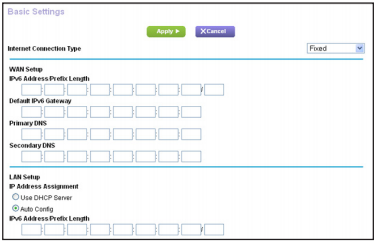
6. Configure the fixed IPv6 addresses for the WAN connection:
• IPv6 Address/Prefix Length. The IPv6 address and prefix length of the router WAN interface.
• Default IPv6 Gateway. The IPv6 address of the default IPv6 gateway for the router’s WAN interface.
• Primary DNS Server. The primary DNS server that resolves IPv6 domain name records for the router.
• Secondary DNS Server. The secondary DNS server that resolves IPv6 domain name records for the router.
Note: If you do not specify the DNS servers, the router uses the DNS servers that are configured for the IPv4 Internet connection on the Internet
Setup page. (See Manually Set Up the Internet Connection)
7. Select an IP Address Assignment radio button:
• Use DHCP Server. This method passes more information to LAN devices, but some IPv6 systems might not support the DHCv6 client function.
• Auto Config. This is the default setting.
This setting specifies how the router assigns IPv6 addresses to the devices on your home network (the LAN).
8. In the IPv6 Address/Prefix Length fields, specify the static IPv6 address and prefix length of the router’s LAN interface.
If you do not specify an ID here, the router generates one automatically from its MAC address.
9. Click the Apply button.
Your settings are saved.
Specify Your Internet Settings 36
AC1750 Smart WiFi Router
Set Up an IPv6 DHCP Internet Connection
⮚ To set up an IPv6 Internet connection with a DHCP server:
1. Launch an Internet browser from a computer or wireless device that is connected to the network.
2. Type http://www.routerlogin.net or http://www.routerlogin.com.
A login window opens.
3. Enter the router user name and password.
The user name is admin. The default password is password. The user name and password are case-sensitive.
The BASIC Home page displays.
4. Select ADVANCED > Advanced Setup > IPv6.
The IPv6 page displays.
5. In the Internet Connection Type menu, select DHCP.
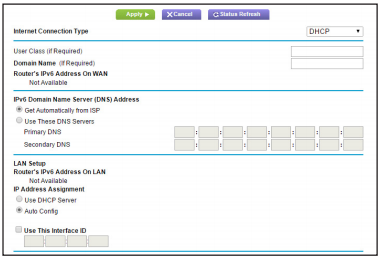
The router automatically detects the information in the following fields:
• Router’s IPv6 Address on WAN. This field shows the IPv6 address that is acquired for the router’s WAN (or Internet) interface. The number after the slash (/) is the length of the prefix, which is also indicated by the underline (_) under the IPv6 address. If no address is acquired, the field displays Not Available.
• Router’s IPv6 Address on LAN. This field shows the IPv6 address that is acquired for the router’s LAN interface. The number after the slash (/) is the length of the prefix, which is also indicated by the underline (_) under the IPv6 address. If no address is acquired, the field displays Not Available.
6. Select an IPv6 Domain Name Server (DNS) Address radio button:
• Get Automatically from ISP. Your ISP uses DHCP to assign your DNS servers. Your ISP automatically assigns this address.
• Use These DNS Servers. If you know that your ISP requires specific servers, select this option. Enter the IP address of your ISP’s primary DNS server. If a secondary DNS server address is available, enter it also.
7. (Optional) In the User Class (If Required) field, enter a host name.
Most people can leave this field blank, but if your ISP gave you a specific host name, enter it here.
8. (Optional) In the Domain Name (If Required) field, enter a domain name.
You can type the domain name of your IPv6 ISP. Do not enter the domain name for the IPv4 ISP here. For example, if your ISP’s mail server is mail.xxx.yyy.zzz, type xxx.yyy.zzz as the domain name. If your ISP provided a domain name, type it in this field. For example, Earthlink Cable might require a host name of home, and Comcast sometimes supplies a domain name.
9. Select an IP Address Assignment radio button:
• Use DHCP Server. This method passes more information to LAN devices, but some IPv6 systems might not support the DHCv6 client function.
• Auto Config. This is the default setting.
This setting specifies how the router assigns IPv6 addresses to the devices on your home network (the LAN).
10. (Optional) Select the Use This Interface ID check box and specify the interface ID that you want to be used for the IPv6 address of the router’s LAN interface.
If you do not specify an ID here, the router generates one automatically from its MAC address.
11. Click the Apply button.
Your settings are saved.
Set Up an IPv6 PPPoE Internet Connection
⮚ To set up a PPPoE IPv6 Internet connection:
1. Launch an Internet browser from a computer or wireless device that is connected to the network.
2. Type http://www.routerlogin.net or http://www.routerlogin.com.
A login window opens.
3. Enter the router user name and password.
The user name is admin. The default password is password. The user name and password are case-sensitive.
The BASIC Home page displays.
4. Select ADVANCED > Advanced Setup > IPv6.
The IPv6 page displays.
5. In the Internet Connection Type menu, select PPPoE.
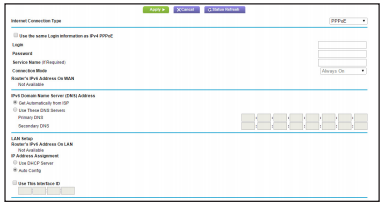
6. Enter the settings that your service provider gave you.
If your service provider gave you only one user name and password, the service provider most likely supports dual stack PPPoE (a single PPP session). If the service provider gave you two user names and passwords for IPv4 and IPv6, then the router must use different PPP session.
• To use separate PPP sessions (the default setting), leave the Use the same Login information as IPv4 PPPoE check box cleared and complete the PPP Login and Password fields.
• To use a single PPP session to establish the IPv4 and IPv6 Internet connection, select the Use the same Login information as IPv4 PPPoE check box.
The page adjusts and the router automatically detects the information in Router’s IPv6 Address on WAN field. Go to Step 10.
Note: If you do not see the Use the same Login information as IPv4
PPPoE check box, make sure that PPPoE is selected from the
Internet Service Provider menu on the Internet Setup page.
For more information, see Specify an Internet Connection That Uses a
Login
The Router’s IPv6 Address on WAN field shows the IPv6 address that is acquired for the router’s WAN (or Internet) interface. The number after the slash (/) is the length of the prefix, which is also indicated by the underline (_) under the IPv6 address. If no address is acquired, the field displays Not Available.
The Router’s IPv6 Address on LAN field shows the IPv6 address that is acquired for the router’s LAN interface. The number after the slash (/) is the length of the prefix, which is also indicated by the underline (_) under the IPv6 address. If no address is acquired, the field displays Not Available.
7. In the Login field, enter the login information for the ISP connection.
This is usually the name that you use in your email address. For example, if your main mail account is JerAB@ISP.com, you would type JerAB in this field. Some ISPs (like Mindspring, Earthlink, and T-DSL) require that you use your full email address when you log in. If your ISP requires your full email address, type it in this field.
8. In the Password field, enter the password for the ISP connection.
9. In the Service Name field, enter a service name.
If your ISP did not provide a service name, leave this field blank.
Note: The default setting of the Connection Mode menu is Always On to provide a steady IPv6 connection. The router never terminates the connection. If the connection is terminated, for example, when the modem is turned off, the router attempts to re-establish the connection immediately after the PPPoE connection becomes available again.
10. Select an IPv6 Domain Name Server (DNS) Address radio button:
• Get Automatically from ISP. Your ISP uses DHCP to assign your DNS servers. Your ISP automatically assigns this address.
• Use These DNS Servers. If you know that your ISP requires specific servers, select this option. Enter the IP address of your ISP’s primary DNS server. If a secondary DNS server address is available, enter it also.
11. Select an IP Address Assignment radio button:
• Use DHCP Server. This method passes more information to LAN devices, but some IPv6 systems might not support the DHCv6 client function.
• Auto Config. This is the default setting.
This setting specifies how the router assigns IPv6 addresses to the devices on your home network (the LAN).
12. (Optional) Select the Use This Interface ID check box and specify the interface ID that you want to be used for the IPv6 address of the router’s LAN interface.
If you do not specify an ID here, the router generates one automatically from its MAC address.
13. Click the Apply button.
Your settings are saved.
Change the MTU Size
The maximum transmission unit (MTU) is the largest data packet a network device transmits. When one network device communicates across the Internet with another, the data packets travel through many devices along the way. If a device in the data path uses a lower MTU setting than the other devices, the data packets must be split or “fragmented” to accommodate the device with the smallest MTU.
The best MTU setting for NETGEAR equipment is often the default value. In some situations, changing the value fixes one problem but causes another. Leave the MTU unchanged unless one of these situations occurs:
• You experience problems connecting to your ISP or other Internet service, and the technical support of either the ISP or NETGEAR recommends changing the MTU setting. These web-based applications might require an MTU change:
– A secure website that does not open or displays only part of a web page – Yahoo email
– MSN portal
– America Online’s DSL service
• You use VPN and experience severe performance problems.
• You used a program to optimize MTU for performance reasons, and now you are experiencing connectivity or performance problems.
Note: An incorrect MTU setting can cause Internet communication problems. For example, you might not be able to access certain websites, frames within websites, secure login pages, or FTP or POP servers.
⮚ To change the MTU size:
1. Launch an Internet browser from a computer or wireless device that is connected to the network.
2. Type http://www.routerlogin.net or http://www.routerlogin.com.
A login window opens.
3. Enter the router user name and password.
The user name is admin. The default password is password. The user name and password are case-sensitive.
The BASIC Home page displays.
4. Select ADVANCED > Setup > WAN Setup.
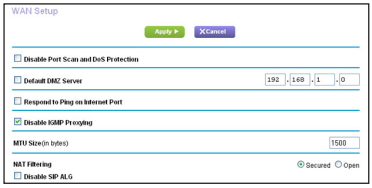
5. In the MTU Size field, enter a value from 64 to 1500.
6. Click the Apply button.
Your change is saved.
If you suspect an MTU problem, a common solution is to change the MTU to 1400. If you are willing to experiment, you can gradually reduce the MTU from the maximum value of 1500 until the problem goes away. The following table describes common MTU sizes and applications.
Table 2. Common MTU sizes
| MTU | Application |
| 1500 | The largest Ethernet packet size. This setting is typical for connections that do not use PPPoE or VPN, and is the default value for NETGEAR routers, adapters, and switches. |
| 1492 | Used in PPPoE environments. |
| 1472 | Maximum size to use for pinging. (Larger packets are fragmented.) |
| 1468 | Used in some DHCP environments. |
| 1460 | Usable by AOL if you do not send or receive large email attachments, for example. |
| 1436 | Used in PPTP environments or with VPN. |
| 1400 | Maximum size for AOL DSL. |
| 576 | Typical value to connect to dial-up ISPs. |
Enable the Bridge or Add a VLAN Tag Group
Some devices, such as an IPTV, cannot work behind a router’s Network Address Translation (NAT) or firewall. Based on what your Internet service provider (ISP) requires, to allow the device to connect to the ISP’s network directly, you must enable the bridge between the device and the router’s Internet port or add new VLAN tag groups to the bridge.
Enable the Bridge
If your device, such as an IPTV, is connected to the router’s Ethernet port or WiFi network, you can enable the bridge so that the packets sent between the device and the router’s Internet port are not processed through the router’s Network Address Translation (NAT).
⮚ To enable the bridge:
1. Launch an Internet browser from a computer or wireless device that is connected to the network.
2. Type http://www.routerlogin.net or http://www.routerlogin.com.
A login window opens.
3. Enter the router user name and password.
The user name is admin. The default password is password. The user name and password are case-sensitive.
The BASIC Home page displays.
4. Select ADVANCED > Advanced Setup > VLAN / Bridge Settings.
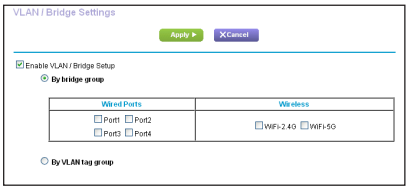
5. Select the Enable VLAN / Bridge group check box.
6. Select the By bridge group radio button.
7. Select a Wired Ports check box or a Wireless check box:
• If your device is connected to an Ethernet port on the router, select a Wired Ports check box that corresponds to the Ethernet port on the router to which the device is connected.
• If your device is connected to your router’s WiFi network, select a Wireless check box that corresponds to the router’s WiFi network to which the device is connected.
Note: You must select at least one Wired Ports or Wireless check box. You can select more than one check box.
8. Click the Apply button.
Your settings are saved.
Add VLAN Tag Groups
You can add VLAN tag groups to the bridge and assign VLAN IDs and priority values to each VLAN tag group.
If you add a VLAN tag group to the bridge, packets sent between the device and the router’s Internet port are not processed through the router’s Network Address Translation (NAT) or firewall.
⮚ To add a VLAN tag group:
1. Launch an Internet browser from a computer or wireless device that is connected to the network.
2. Type http://www.routerlogin.net or http://www.routerlogin.com.
A login window opens.
3. Enter the router user name and password.
The user name is admin. The default password is password. The user name and password are case-sensitive.
The BASIC Home page displays.
4. Select ADVANCED > Advanced Setup > VLAN / Bridge Settings. The VLAN/Bridge Settings page displays.
5. Select the Enable VLAN / Bridge group check box.
6. Leave the By VLAN tag group radio button selected.
7. Click the Add button.
The Add Vlan Rule pop-up window opens.
8. In the Name field, enter a name for the VLAN tag group.
The name can be up to 10 characters.
9. In the VLAN ID field, enter a value from 1 to 4094.
This value is provided by your Internet service provider.
10. In the Priority field, enter a value from 0 to 7.
This value is provided by your Internet service provider.
11. Select a Wired Ports check box or a Wireless check box:
• If your device is connected to an Ethernet port on the router, select a Wired Ports check box that corresponds to the Ethernet port on the router to which the device is connected.
• If your device is connected to your router’s WiFi network, select a Wireless check box that corresponds to the router’s WiFi network to which the device is connected to.
Note: You must select at least one Wired Ports or Wireless check box. You can select more than one check box.
12. Click the Add button.
The VLAN tag group is added.
13. Click the Apply button.
Your settings are saved.
4. Optimize Performance
This chapter contains the following sections:
• Prioritize Internet Traffic with Quality of Service
• Optimize Internet Gaming with Upstream QoS
• Add Upstream QoS Rules
• Optimize Video Streaming with Downstream QoS
• Improve Network Connections with Universal Plug and Play
• Wi-Fi Multimedia Quality of Service
Prioritize Internet Traffic with Quality of Service
You can use Quality of Service (QoS) to assign a high priority to gaming and streaming video from the Internet.

Figure 6. You can prioritize downstream traffic, upstream traffic, or both
Optimize Internet Gaming with Upstream QoS
Upstream Quality of Service (QoS) assigns a high priority to Internet traffic from your Xbox gaming system.
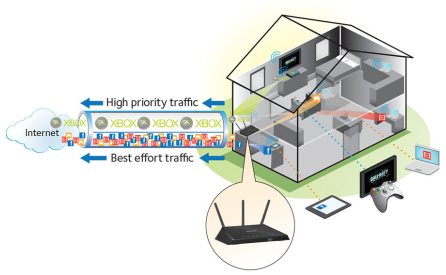
Figure 7. Upstream QoS assigns a high priority to gaming traffic from your Xbox
NETGEAR recommends that only gamers enable the Upstream QoS feature. If you do not game and you turn on this feature, some applications might not perform as well as usual.
⮚ To enable upstream QoS:
1. Launch an Internet browser from a computer or wireless device that is connected to the network.
2. Type http://www.routerlogin.net or http://www.routerlogin.com.
A login window opens.
3. Enter the router user name and password.
The user name is admin. The default password is password. The user name and password are case-sensitive.
The BASIC Home page displays.
4. Select ADVANCED > Setup > QoS Setup > Upstream QoS.
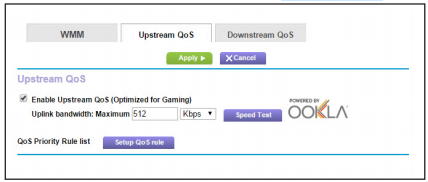
5. Select the Enable Upstream QoS (Optimized for Gaming) check box. 6. Specify the maximum uplink bandwidth for your Internet connection:
• If you know what your uplink bandwidth is, type it in the Uplink bandwidth Maximum field.
• If you are not sure, click the Speed Test button.
Speedtest verifies the upstream speed of your Internet connection. The Uplink bandwidth Maximum field displays the result of the test.
7. Click the Apply button.
The router assigns a high priority to Internet traffic from your gaming devices to the Internet.
Add Upstream QoS Rules
You can give prioritized Internet access to the following types of traffic:
• Specific applications
• Specific online games
• Individual Ethernet LAN ports of the router
• A specific device by MAC address
To specify prioritization of traffic, create a policy for the type of traffic and add the policy to the QoS Policy table in the QoS Setup page. For convenience, the QoS Policy table lists many common applications and online games that can benefit from QoS handling.
Set Up QoS for Applications and Online Gaming
⮚ To create a QoS policy for applications and online games:
1. Launch an Internet browser from a computer or wireless device that is connected to the network.
2. Type http://www.routerlogin.net or http://www.routerlogin.com.
A login window opens.
3. Enter the router user name and password.
The user name is admin. The default password is password. The user name and password are case-sensitive.
The BASIC Home page displays.
4. Select ADVANCED > Setup > QoS Setup > Upstream QoS.
The Upstream QoS page displays.
5. Click the Setup QoS rule button.
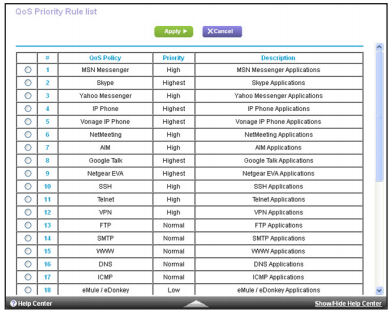
6. To add a priority rule, scroll down to the bottom of the QoS Setup page and click the Add Priority Rule button.
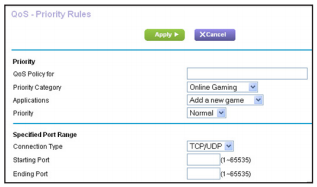
7. In the QoS Policy for field, type the name of the application or game.
8. In the Priority Category menu, select either Applications or Online Gaming. A list of applications or games displays.
9. Scroll and select Add a New Application or Add a New Game, as applicable.
10. If prompted, in the Connection Type menu, select either TCP, UDP, or TCP/UDP (both). Specify the port number or range of port numbers that the application or game uses.
11. From the Priority menu, select the priority for Internet access for this traffic relative to other applications and traffic.
The options are Low, Normal, High, and Highest.
12. Click the Apply button.
The rule is saved.
Set Up QoS for a Router LAN Port
⮚ To create a QoS policy for a device connected to one of the router’s LAN ports:
1. Launch an Internet browser from a computer or wireless device that is connected to the network.
2. Type http://www.routerlogin.net or http://www.routerlogin.com.
A login window opens.
3. Enter the router user name and password.
The user name is admin. The default password is password. The user name and password are case-sensitive.
The BASIC Home page displays
4. Select ADVANCED > Setup > QoS Setup.
The QoS Setup page displays.
5. Select the Turn Internet Access QoS On check box.
6. Select ADVANCED > Setup > QoS Setup > Upstream QoS.
The Upstream QoS page displays.
7. Click the Setup QoS Rule button.
The QoS Priority Rule list displays.
8. Scroll down and click the Add Priority Rule button.
The QoS – Priority Rules page displays.
9. From the Priority Category menu, select Ethernet LAN Port.
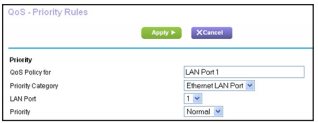
10. From the QoS Policy for menu, select the LAN port.
11. From the Priority menu, select the priority for Internet access for this port’s traffic relative to other applications.
The options are Low, Normal, High, and Highest.
12. Click the Apply button.
The rule is saved in the QoS Policy menu.
Set Up QoS for a MAC Address
⮚ To create a QoS policy for traffic from a specific MAC address:
1. Launch an Internet browser from a computer or wireless device that is connected to the network.
2. Type http://www.routerlogin.net or http://www.routerlogin.com.
A login window opens.
3. Enter the router user name and password.
The user name is admin. The default password is password. The user name and password are case-sensitive.
The BASIC Home page displays.
4. Select ADVANCED > Setup > QoS Setup > Upstream QoS.
The Upstream QoS page displays.
5. Click the Setup QoS Rule button.
The QoS Priority Rule menu displays.
6. Scroll down and click the Add Priority Rule button.
The QoS – Priority Rules page displays.
7. From the Priority Category menu, select MAC Address.
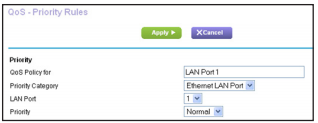
8. If the device is in the MAC Device List, select its radio button.
The information from the MAC Device List populates the QoS Policy for, MAC Address, and Device Name fields. If the device is not in the MAC Device List, click the Refresh button. If it still does not display, complete these fields.
9. From the Priority menu, select Highest.
This is the priority for Internet access for this device’s traffic relative to other applications and traffic. The options are Low, Normal, High, and Highest.
10. Click the Apply button.
This rule is saved.
Edit an Upstream QoS Policy
⮚ To edit a QoS policy:
1. Launch an Internet browser from a computer or wireless device that is connected to the network.
2. Type http://www.routerlogin.net or http://www.routerlogin.com.
A login window opens.
3. Enter the router user name and password.
The user name is admin. The default password is password. The user name and password are case-sensitive.
The BASIC Home page displays.
4. Select ADVANCED > Setup > QoS Setup > Upstream QoS.
The Upstream QoS page displays.
5. Click the Setup QoS Rule button.
The Setup QoS Rule page displays.
6. Select the radio button for the QoS policy.
7. Scroll down and click the Edit button.
The Edit pop-up window opens.
8. Change the policy settings.
9. Click the Apply button.
Your changes are saved.
Delete an Upstream QoS Policy
⮚ To delete a QoS policy:
1. Launch an Internet browser from a computer or wireless device that is connected to the network.
2. Type http://www.routerlogin.net or http://www.routerlogin.com.
A login window opens.
3. Enter the router user name and password.
The user name is admin. The default password is password. The user name and password are case-sensitive.
The BASIC Home page displays.
4. Select ADVANCED > Setup > QoS Setup > Upstream QoS.
The Upstream QoS page displays.
5. Click the Setup QoS Rule button.
The Setup Rules page displays.
6. Select the radio button for the QoS policy.
7. Click the Delete button.
The QoS Policy is removed from the menu.
Optimize Video Streaming with Downstream QoS
Downstream Quality of Service (QoS) assigns a high priority to Internet video streaming from websites like YouTube and Netflix.
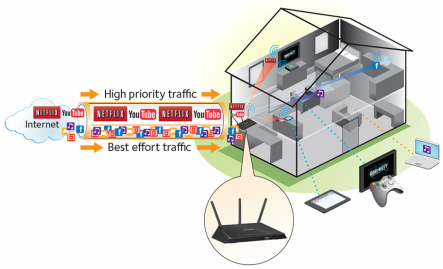
Figure 8. Downstream QoS assigns a high priority to video streaming from the Internet
NETGEAR recommends that you enable downstream QoS only if you watch streaming Internet video. When downstream QoS assigns a high priority to streaming video, it also assigns a lower priority to the rest of your Internet traffic. That means other tasks like downloading content from the Internet take longer.
⮚ To enable downstream QoS:
1. Launch an Internet browser from a computer or wireless device that is connected to the network.
2. Type http://www.routerlogin.net or http://www.routerlogin.com.
A login window opens.
3. Enter the router user name and password.
The user name is admin. The default password is password. The user name and password are case-sensitive.
The BASIC Home page displays.
4. Select ADVANCED > Setup > QoS Setup > Downstream QoS.
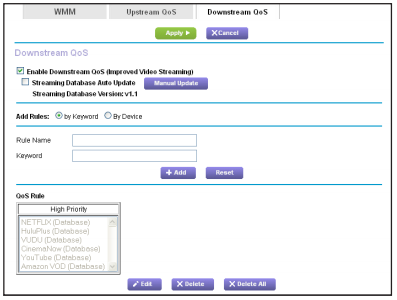
5. Select the Enable Downstream QoS (Improved Video Streaming) check box. 6. (Optional) Select the Streaming Database Auto Upgrade check box.
The router automatically checks for updates for the streaming database, and downloads and installs them.
7. Click the Apply button.
The router assigns a high priority to video streaming from the Internet traffic.
Add Downstream QoS Rules by Keyword
⮚ To add a downstream QoS rule by keyword:
1. Launch an Internet browser from a computer or wireless device that is connected to the network.
2. Type http://www.routerlogin.net or http://www.routerlogin.com.
A login window opens.
3. Enter the router user name and password.
The user name is admin. The default password is password. The user name and password are case-sensitive.
The BASIC Home page displays.
4. Select ADVANCED > Setup > QoS Setup > Downstream QoS.
The Downstream QoS page displays.
5. Select the Enable Downstream QoS (Improved Video Streaming) check box.
6. In the Add Rules section, leave the by Keyword radio button selected.
7. In the Rule Name field, type the name of the rule.
8. In the Keyword field, type a keyword.
9. Click the Add button.
The rule is added to the QoS rules. The router assigns a high priority to Internet traffic from the server that matches the keyword.
Add a Downstream QoS Rule by Device
⮚ To add a downstream QoS rule by device:
1. Launch an Internet browser from a computer or wireless device that is connected to the network.
2. Type http://www.routerlogin.net or http://www.routerlogin.com.
A login window opens.
3. Enter the router user name and password.
The user name is admin. The default password is password. The user name and password are case-sensitive.
The BASIC Home page displays.
4. Select ADVANCED > Setup > QoS Setup > Downstream QoS.
The Downstream QoS page displays.
5. Select the Enable Downstream QoS (Improved Video Streaming) check box.
6. In the Add Rules section, select the by Device radio button.
The page adjusts.
7. In the MAC Device list, select a radio button for a device.
8. Click the Add button.
The router assigns a high a priority to streaming traffic that goes from the Internet to the device you specified.
Improve Network Connections with Universal Plug and Play
Universal Plug and Play (UPnP) helps devices such as Internet appliances and computers access the network and connect to other devices as needed. UPnP devices can automatically discover the services from other registered UPnP devices on the network.
If you use applications such as multiplayer gaming, peer-to-peer connections, or real-time communications such as instant messaging or remote assistance (a feature in Windows XP), enable UPnP.
⮚ To enable Universal Plug and Play:
1. Launch an Internet browser from a computer or wireless device that is connected to the network.
2. Type http://www.routerlogin.net or http://www.routerlogin.com.
A login window opens.
3. Enter the router user name and password.
The user name is admin. The default password is password. The user name and password are case-sensitive.
The BASIC Home page displays.
4. Select ADVANCED > Advanced Setup > UPnP.
The UPnP page displays.
5. Select the Turn UPnP On check box.
By default, this check box is selected. UPnP for automatic device configuration can be enabled or disabled. If the Turn UPnP On check box is cleared, the router does not allow any device to automatically control router resources, such as port forwarding.
6. Type the advertisement period in minutes.
The advertisement period specifies how often the router broadcasts its UPnP information. This value can range from 1 to 1440 minutes. The default period is 30 minutes. Shorter durations ensure that control points receive current device status at the expense of more network traffic. Longer durations can compromise the freshness of the device status, but can significantly reduce network traffic.
7. Type the advertisement time to live in hops.
The time to live for the advertisement is measured in hops (steps) for each UPnP packet sent. Hops are the steps a packet takes between routers. The number of hops can range from 1 to 255. The default value for the advertisement time to live is 4 hops, which should be fine for most home networks. If you notice that some devices are not being updated or reached correctly, it might be necessary to increase this value.
8. Click the Apply button.
The UPnP Portmap Table displays the IP address of each UPnP device that is accessing the router and which ports (internal and external) that device opened. The UPnP Portmap Table also displays what type of port is open and whether that port is still active for each IP address.
9. To refresh the information in the UPnP Portmap table, click the Refresh button.
Wi-Fi Multimedia Quality of Service
Wi-Fi Multimedia Quality of Service (WMM QoS) prioritizes wireless voice and video traffic over the WiFi link. WMM QoS is automatically enabled for the router.
WMM QoS prioritizes wireless data packets from different applications based on four access categories: voice, video, best effort, and background. For an application to receive the benefits of WMM QoS, WMM must be enabled in both it and the client running that application. Legacy applications that do not support WMM and applications that do not require QoS are assigned to the best effort category, which receives a lower priority than voice and video.
⮚ To disable WMM QoS:
1. Launch an Internet browser from a computer or wireless device that is connected to the network.
2. Type http://www.routerlogin.net or http://www.routerlogin.com.
A login window opens.
3. Enter the router user name and password.
The user name is admin. The default password is password. The user name and password are case-sensitive.
The BASIC Home page displays.
4. Select ADVANCED > Setup > QoS Setup.
The QoS Setup page displays.
5. Clear the Enable WMM (Wi-Fi multimedia) settings (2.4 GHz b/g/n) check box. 6. Clear the Enable WMM (Wi-Fi multimedia) settings (5 GHz b/g/n) check box. 7. Click the Apply button.
Your changes are saved.
5.Control Access to the Internet
The router comes with a built-in firewall that helps protect your home network from unwanted intrusions from the Internet.
This chapter includes the following sections:
• Set Up Parental Controls
• Block Access to Your Network
• Use Keywords to Block Internet Sites
• Block Services from the Internet
• Schedule When to Block Internet Sites and Services
• Avoid Blocking on a Trusted Computer
• Set Up Security Event Email Notifications
Set Up Parental Controls
The first time that you select Parental Controls from the BASIC Home page, your browser goes to the Parental Controls website, where you can learn more about Parental Controls. To set up Parental Controls, you must download the genie app.
⮚ To set up Parental Controls:
1. Launch an Internet browser from a computer or WiFi device that is connected to the network.
2. Type http://www.routerlogin.net.
A login window opens.
3. Enter the user name and password for the router.
The user name is admin. The default password is password. The user name and password are case-sensitive.
The BASIC Home page displays.
4. Select Parental Controls.
The Parental Controls website opens.
5. Click the button for the genie app or version that you want to download and use. 6. Follow the onscreen instructions to download and install the genie app. 7. Open the genie app and select Parental Controls.
Live Parental Controls automatically starts.
8. Click the Next button, read the note, and click the Next button again.
Because Live Parental Controls uses free OpenDNS accounts, you are prompted to log in or create a free account.

9. Select a radio button as follows:
• If you already own an OpenDNS account, leave the Yes radio button selected. • If you did not yet create an OpenDNS account, select the No radio button. If you are creating an account, the Create a free OpenDNS account page displays. Do the following:
a. Complete the fields.
b. Click the Next button.
After you log on or create your account, the filtering level page displays.
10. Select a radio button for a filtering level and click the Next button.
The Setup is complete page displays.
11. Click the Take me to the status page button.
The Status page displays. Parental Controls are now set up for the router.
12. To enable Parental Controls, click the Enable Live Parental Controls button.
Block Access to Your Network
You can use access control to block access to your network.
⮚ To set up access control:
1. Launch an Internet browser from a computer or wireless device that is connected to the network.
2. Type http://www.routerlogin.net or http://www.routerlogin.com.
A login window opens.
3. Enter the router user name and password.
The user name is admin. The default password is password. The user name and password are case-sensitive.
The BASIC Home page displays.
4. Select ADVANCED > Security > Access Control.
The Access Control page displays.
5. Select the Turn on Access Control check box.
You must select this check box before you can specify an access rule and use the Allow and Block buttons. When this check box is cleared, all devices are allowed to connect, even if the device is in the blocked list.
6. To specify the access rule, select one of the following radio buttons:
• Allow all new devices to connect. With this setting, if you buy a new device, it can access your network. You don’t need to enter its MAC address in this page. NETGEAR recommends that you leave this radio button selected.
• Block all new devices from connecting. With this setting, if you buy a new device, before it can access your network, you must enter its MAC address for an Ethernet connection and its MAC address for a WiFi connection in the allowed list.
The access rule does not affect previously blocked or allowed devices. It applies only to devices joining your network in the future after you apply these settings.
7. To allow the computer or device you’re currently using to continue to access the network, select the check box next to your computer or device, and click the Allow button.
8. Click the Apply button.
Your changes take effect.
Use Keywords to Block Internet Sites
You can use keywords to block certain Internet sites from your network. You can use blocking all the time or based on a schedule.
⮚ To set block Internet sites:
1. Launch an Internet browser from a computer or wireless device that is connected to the network.
2. Type http://www.routerlogin.net or http://www.routerlogin.com.
A login window opens.
3. Enter the router user name and password.
The user name is admin. The default password is password. The user name and password are case-sensitive.
The BASIC Home page displays.
4. Select ADVANCED > Security > Block Sites.
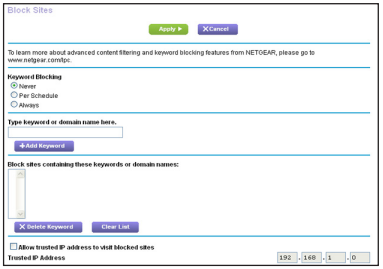
Select one of the keyword blocking options:
• Per Schedule. Turn on keyword blocking according to the Schedule page settings.
(See Schedule When to Block Internet Sites and Services on page 64.)
• Always. Turn on keyword blocking all the time, independent of the Schedule page.
- In the Type a keyword or domain name here field, enter a keyword or domain that you want to block.
For example:
• Specify XXX to block http://www.badstuff.com/xxx.html.
• Specify .com if you want to allow only sites with domain suffixes such as .edu or .gov. • Enter a period (.) to block all Internet browsing access.
7. Click the Add Keyword button.
The keyword is added to the keyword list. The keyword list supports up to 32 entries. 8. Click the Apply button.
Keyword blocking takes effect.
Delete Keywords from the List to Be Blocked
⮚ To delete keywords from the list:
1. Launch a web browser from a computer or wireless device that is connected to the network.
2. Type http://routerlogin.net or http://routerlogin.com.
A login window opens.
3. Enter the router user name and password.
The user name is admin. The default password is admin. The user name and password are case-sensitive.
The BASIC Home page displays.
4. Select ADVANCED > Security > Block Sites.
5. Do one of the following:
• To delete a single word, select it and click the Delete Keyword button. The keyword is removed from the list.
• To delete all keywords on the list, click the Clear List button.
All keywords are removed from the list.
6. Click the Apply button.
Your changes are saved.
Block Services from the Internet
You can block Internet services on your network based on the type of service. You can block the services all the time or based on a schedule.
⮚ To block services:
1. Launch an Internet browser from a computer or wireless device that is connected to the network.
2. Type http://www.routerlogin.net or http://www.routerlogin.com.
A login window opens.
3. Enter the router user name and password.
The user name is admin. The default password is password. The user name and password are case-sensitive.
The BASIC Home page displays.
4. Select ADVANCED > Security > Block Services.
The Block Services page displays.
5. Specify when to block the services:
• To block the services all the time, select the Always radio button.
• To block the services based on a schedule, select the Per Schedule radio button.
For information about how to specify the schedule, see Schedule When to Block Internet Sites and Services on page 64.
6. Click the Add button.
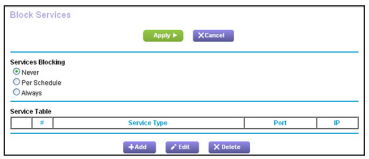
7. To add a service that is in the Service Type menu, select the application or service. The settings for this service automatically display in the fields.
8. To add a service or application that is not the menu, select User Defined and do the following:
a. If you know that the application uses either TCP or UDP, select the appropriate protocol. Otherwise, select TCP/UDP (both).
b. Enter the starting port and ending port numbers.
If the service uses a single port number, enter that number in both fields.
To find out which port numbers the service or application uses, you can contact the publisher of the application, ask user groups or newsgroups, or search on the Internet.
9. To specify how to filter the services, select one of the following radio buttons:
• Only This IP Address. Block services for a single computer.
• IP Address Range. Block services for a range of computers with consecutive IP addresses on your network.
• All lP Addresses. Block services for all computers on your network.
10. Click the Add button.
Your changes are saved.
Schedule When to Block Internet Sites and Services
When you schedule blocking, the same schedule is used to block sites and to block services. For information about how to specify what you want the router to block, see Use Keywords to Block Internet Sites on page 61 and Block Services from the Internet on page 62.
⮚ To schedule blocking:
1. Launch an Internet browser from a computer or wireless device that is connected to the network.
2. Type http://www.routerlogin.net or http://www.routerlogin.com.
A login window opens.
3. Enter the router user name and password.
The user name is admin. The default password is password. The user name and password are case-sensitive.
The BASIC Home page displays.
4. Select ADVANCED > Security > Schedule.
The Schedule page displays.
5. Specify when to block keywords and services:
• Days to Block. Select the check box for each day that you want to block the keywords, or select the Every Day check box, which automatically selects the check boxes for all days.
• Time of Day to Block. Select a start and end time in 24-hour format, or select All Day for 24-hour blocking.
6. Select your time zone.
7. If you live in an area that observes daylight saving time, select the Automatically adjust for daylight savings time check box.
8. Click the Apply button.
Your settings are saved.
Avoid Blocking on a Trusted Computer
You can exempt one trusted computer from blocking. The computer you exempt must use a fixed IP address. You can use the reserved IP address feature to specify the IP address. See Manage Reserves LAN IP Addresses on page 114.
⮚ To specify a trusted computer:
1. Launch an Internet browser from a computer or wireless device that is connected to the network.
2. Type http://www.routerlogin.net or http://www.routerlogin.com.
A login window opens.
3. Enter the router user name and password.
The user name is admin. The default password is password. The user name and password are case-sensitive.
The BASIC Home page displays.
4. Select ADVANCED > Security > Block Sites.
The Block Sites page displays.
5. Scroll down and select the Allow trusted IP address to visit blocked sites check box. 6. In the Trusted IP Address field, enter the IP address of the trusted computer. 7. Click the Apply button.
Your changes are saved.
Set Up Security Event Email Notifications
The router can email you its logs of router activity. The log records router activity and security events such as attempts to access blocked sites or services.
⮚ To set up email notifications:
1. Launch an Internet browser from a computer or wireless device that is connected to the network.
2. Type http://www.routerlogin.net or http://www.routerlogin.com.
A login window opens.
3. Enter the router user name and password.
The user name is admin. The default password is password. The user name and password are case-sensitive.
The BASIC Home page displays.
4. Select ADVANCED > Security > E-mail.
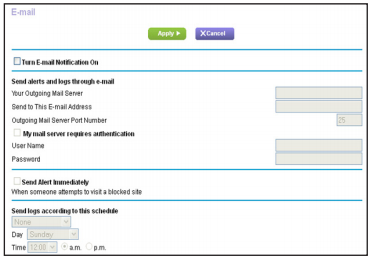
5. Select the Turn E-mail Notification On check box.
6. In the Your Outgoing Mail Server field, enter the name of your ISP outgoing (SMTP) mail server (such as mail.myISP.com).
You might be able to find this information in the configuration page of your email program. If you leave this field blank, log and alert messages are not sent.
7. Enter the email address to which logs and alerts are sent in the Send to This E-mail Address field.
This email address is also used for the From address. If this field is blank, log and alert messages are not sent.
8. If your outgoing email server requires authentication, select the My Mail Server requires authentication check box.
a. In the User Name field, type the user name for the outgoing email server. b. In the Password field, type the password for the outgoing email server. 9. To send alerts immediately, select the Send Alerts Immediately check box. 10. To send logs based on a schedule, specify these settings:
• From Send logs according to this schedule menu, select the schedule type. • From the Day menu, select the day.
• From the Time menu, select the time, and select the am or pm radio button. 11. Click the Apply button.
Your settings are saved.
Logs are sent automatically. If the log fills before the specified time, it is sent. After the log is sent, it is cleared from the router memory. If the router cannot email the log and the log buffer fills, the router overwrites the log.
6.Share USB Storage Devices Attached to the Router
This chapter describes how to access and configure a USB storage drive attached to your router. The USB port on the router can be used only to connect USB storage devices like flash drives or hard drives, or a printer. Do not connect computers, USB modems, CD drives, or DVD drives to the router USB port.
Note: NETGEAR recommends that you connect a USB storage device to the USB 3.0-Storage port and connect a printer to the USB 2.0-Printer
This chapter contains the following sections:
• USB Storage Device Requirements
• Access a USB Storage Device on the Network
• Back Up Windows Computers with ReadySHARE Vault
• Back Up Mac Computers with Time Machine
• Control Access to the USB Drive
• Use FTP Within the Network
• View or Change Network Folders on a USB Drive
• Add a Network Folder on a USB Drive
• Edit a Network Folder on a USB Drive
• Safely Remove a USB Drive
For more information about ReadySHARE features, visit www.netgear.com/readyshare.
USB Storage Device Requirements
The router works with most USB-compliant external flash and hard drives. For the most up-to-date list of USB drives that the router supports, visit
http://kbserver.netgear.com/readyshare.
Some USB external hard drives and flash drives require you to load the drivers onto the computer before the computer can access the USB device. Such USB devices do not work with the router.
The router supports the following file system types for full read/write access: • FAT16
• FAT32
• NTFS
• NTFS with compression format enabled
• Ext2
• Ext3
• Ext4
• XFS
• HFS
• HFS+
Access a USB Storage Device on the Network
ReadySHARE lets you access and share a USB drive connected to the router USB port. (If your USB drive uses special drivers, it is not compatible.)
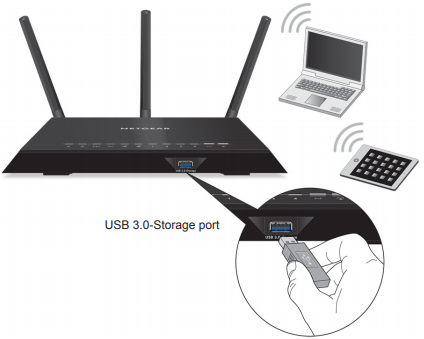
Figure 9. The blue USB 3.0-Storage port on the front of the router provides the fastest access
⮚ To connect a USB storage device to the router:
Connect your USB storage device to the USB port on the router.
If your USB device uses a power supply, you must use it when you connect the USB device to the router.
When you connect the USB device to the router USB port, it might take up to two minutes before it is ready for sharing. By default, the USB device is available to all computers on your local area network (LAN).
⮚ To access the USB device from a Mac:
1. Connect your USB storage device to the USB port on the router.
If your USB device uses a power supply, you must use it when you connect the USB device to the router.
When you connect the USB storage device to the router’s USB port, it might take up to two minutes before it is ready for sharing. By default, the USB drive is available to all computers on your local area network (LAN).
2. On a Mac that is connected to the network, launch Finder and select Go > Connect to Server.
The Connect to Server page displays.
3. Enter the smb://readyshare in the Server Address field.
4. Click the Connect button.
5. When prompted, select the Guest radio button.
6. If you set up access control on the router and you allowed your Mac to access the network, select the Registered User radio button and enter admin for the name and password for the password.
For more information about access control, see Block Access to Your Network on page 60.
7. Click the Connect button.
A window automatically opens and displays the files and folders on the device.
⮚ To access the USB storage device from a Windows computer:
1. Connect your USB storage device to a USB port on the router.
If your USB device uses a power supply, you must use it when you connect the USB device to the router.
When you connect the USB storage device to the router’s USB port, it might take up to two minutes before it is ready for sharing. By default, the USB drive is available to all computers on your local area network (LAN).
2. Select Start > Run.
3. Enter \\readyshare in the dialog box.
4. Click the OK button.
A window automatically opens and displays the files and folders on the device.
⮚ To map the USB device to a Windows network drive:
1. Connect your USB storage device to the USB port on the router.
If your USB device uses a power supply, you must use it when you connect the USB device to the router.
When you connect the USB device to the router’s USB port, it might take up to two minutes before it is ready for sharing. By default, the USB drive is available to all computers on your local area network (LAN).
2. Select Start > Run.
3. Enter \\readyshare in the dialog box.
4. Click the OK button.
A window automatically opens and displays the USB Storage device.
5. Right-click the USB storage device and select Map network drive.
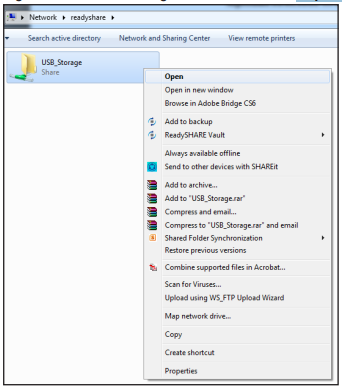
The Map Network Drive page displays:

6. Select the drive letter to map to the network folder.
7. Click the Finish button.
8. To connect to the USB storage device as a different user, select the Connect using different credentials check box, click the Finish button, and do the following:
a. Type the user name and password.
b. Click the OK button.
The USB storage device is mapped to the drive letter that you specified.
Back Up Windows Computers with ReadySHARE Vault
Your router comes with free backup software for all the Windows computers in your home. Connect a USB hard disk drive (HDD) to the USB port on your router for centralized, continuous, and automatic backup.
⮚ To back up your Windows computer:
1. Connect a USB HDD to a USB port on the router.
The blue USB 3.0-Storage port on the front of the router performs faster than the USB 2.0-Printer port on the rear panel of the router.
2. Install the genie app on each Windows computer.
To download the genie app, visit www.netgear.com/genie.
3. Download ReadySHARE Vault from www.netgear.com/readyshare and install it on each Windows computer.
4. Launch ReadySHARE Vault.
5. Use the dashboard or the Backup tab to set up and run your backup.
Back Up Mac Computers with Time Machine
You can use Time Machine to back up your Mac computers onto a USB hard disk drive (HDD) that is connected to one of the router’s USB ports. You can access the connected USB hard drive from your Mac with a wired or wireless connection to your router.
Set Up a USB Hard Drive on a Mac
NETGEAR recommends that you use a new USB HDD or format your old USB HDD to do the Time Machine backup for the first time. Use a blank partition to prevent some issues during backup using Time Machine. The router supports GUID or MBR partitions.
⮚ To format your USB hard disk drive and specify partitions:
1. Physically connect the USB hard drive to your Mac.
2. On your Mac, go to Spotlight (or the magnifying glass) at the top right of the page and search for Disk Utility.
3. Open the Disk Utility, click the Erase tab, and click the Erase button.
4. Click the Partition tab.
5. Click Partition Layout and set the number of partitions that you want to use. 6. Click the Options button.
The Partition options display.
7. Select the GUID Partition Table or Master Boot Record radio button. 8. For the format, select Mac OS Extended (Journaled).
9. Click the OK button.
10. Click the Apply button.
Your settings are saved.
Prepare to Back Up a Large Amount of Data
Before you back up a large amount of data with Time Machine, NETGEAR recommends that you follow this procedure.
⮚ To prepare to back up a large amount of data:
1. Upgrade the operating system of the Mac computer.
2. Verify and repair the backup disk and the local disk.
3. Verify and repair the permissions on the local disk.
4. Set Energy Saver:.
a. From the Apple menu, select System Preferences.
The System Preference window displays.
b. Select Energy Saver.
The Energy Saver page displays.
c. Click the Power Adapter tab.
d. Select the Wake for Wi-Fi network access check box.
e. Click the Back arrow to save the changes and exit the page.
5. Modify your security settings.
a. From the System Preferences window, select Security & Privacy.
The Security & Privacy page displays.
b. Click the Advanced button at the bottom of the page.
If the Advanced button is grayed out, click the lock icon so that you can change the settings.
c. Clear the Log out after minutes of inactivity check box.
d. Click the OK button.
Your changes are saved.
Use Time Machine to Back Up onto a USB Hard Drive
You can use Time Machine to back up your Mac computers onto a USB HDD that is connected to one of the router’s USB ports.
⮚ To back up your Mac onto a USB hard drive:
1. Prepare your USB HDD with a compatible format and partitions
For more information, see Set Up a USB Hard Drive on a Mac on page 72.
2. If you plan to back up a large amount of data, see Prepare to Back Up a Large Amount of Data on page 73.
3. Insert your USB HDD into a USB port on the router.
Note: If your USB HDD uses a power supply, you must use it when you connect the USB HDD to the router.
The blue USB 3.0-Storage port on the front of the router performs faster than the USB 2.0-Printer port on the rear panel of the router.
When you connect the USB HDD to the router USB port, it might take up to two minutes before it is ready for sharing. By default, the USB drive is available to all computers on your local area network (LAN).
4. On your Mac computer that is connected to the router’s network, launch Finder and select Go > Connect to Server.
The Connect to Server window displays.
5. Type smb://routerlogin.net and click the Connect button.
6. When prompted, select the Registered User radio button.
7. Enter admin for the name and password for the password and click the Connect button. A list of USB devices connected to your router displays.
8. From the Apple menu, select System Preferences.
The System Preferences window displays.
9. Select Time Machine.
The Time Machine window displays.
10. Click the Select Backup Disk button and select your USB device from the list.
11. Click the Use Disk button.
Note: If you do not see the USB partition that you want in the Time Machine disk list, go to Mac finder and click that USB partition. It displays in the Time Machine list
12. When prompted, select the Registered User radio button.
13. Enter admin for the name and password for the password and click the Connect button.
The setup is complete and the Mac automatically schedules a full back up. You can back up immediately if you want.
Control Access to the USB Drive
You can specify the device name, workgroups, and network folders for your USB device.
⮚ To specify the USB access settings:
1. Launch an Internet browser from a computer or wireless device that is connected to the network.
2. Type http://www.routerlogin.net or http://www.routerlogin.com.
A login window opens.
3. Enter the router user name and password.
The user name is admin. The default password is password. The user name and password are case-sensitive.
The BASIC Home page displays.
4. Select ADVANCED > USB Functions > ReadySHARE Storage.
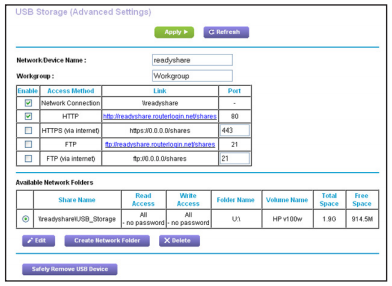
5. Specify access to the USB storage device:
• Network Device Name. This is the name used to access the USB device connected to the router. The default is readyshare.
• Workgroup. If you are using a Windows workgroup rather than a domain, the workgroup name is displayed here. The name works only in an operating system that supports NetBIOS, such as Microsoft Windows.
• Access Method. Select the check boxes for the access methods that you want: – Network Connection. Enabled by default.
– HTTP. Enabled by default. You can type
http://readyshare.routerlogin.net/shares to access the USB drive.
– HTTPS (via Internet). Disabled by default. If you enable this feature, remote users can type http://<public IP address/shares> (for example,
http://1.1.10.102/shares) or a URL domain name to access the USB drive over the Internet. This feature supports file uploading only.
– FTP. Disabled by default.
– FTP (via Internet). Disabled by default. If you select this check box, remote users can access the USB drive through FTP over the Internet. This feature supports both downloading and uploading of files.
6. If you changed the settings, click the Apply button.
Your changes are saved.
Use FTP Within the Network
File Transfer Protocol (FTP) lets you send and receive large files faster.
⮚ To set up FTP access:
1. Launch an Internet browser from a computer or wireless device that is connected to the network.
2. Type http://www.routerlogin.net or http://www.routerlogin.com.
A login window opens.
3. Enter the router user name and password.
The user name is admin. The default password is password. The user name and password are case-sensitive.
The BASIC Home page displays.
4. Select ADVANCED > USB Functions > ReadySHARE Storage.
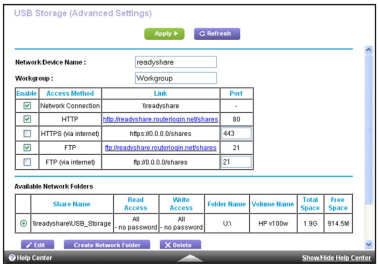
5. Select the FTP check box.
6. Click the Apply button.
Your changes are saved.
View or Change Network Folders on a USB Drive
You can view or change the network folders on the USB storage device.
⮚ To view or change network folders:
1. Launch an Internet browser from a computer or wireless device that is connected to the network.
2. Type http://www.routerlogin.net or http://www.routerlogin.com.
A login window opens.
3. Enter the router user name and password.
The user name is admin. The default password is password. The user name and password are case-sensitive.
The BASIC Home page displays.
4. Select ADVANCED > USB Functions > ReadySHARE Storage.
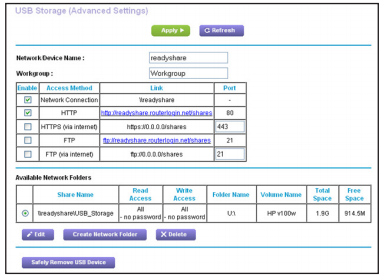
5. Scroll down to the Available Networks Folder section of the page, and adjust the following settings:
• Share Name. If only one device is connected, the default share name is USB_Storage. (Some router models include more than one USB port.)
You can click the name, or you can type it in the address field of your web browser. If Not Shared is shown, the default share was deleted, and no other share for the root folder exists. Click the link to change this setting.
• Read Access and Write Access. Show the permissions and access controls on the network folder. All–no password (the default) allows all users to access the network folder. The password for admin is the same one that you use to log in to the router.
• Folder Name. Full path of the network folder.
• Volume Name. Volume name from the storage device (either USB drive or HDD). • Total Space and Free Space. Show the current utilization of the storage device.
Add a Network Folder on a USB Drive
You can add network folders on the USB storage device.
⮚ To add a network folder:
1. Launch an Internet browser from a computer or wireless device that is connected to the network.
2. Type http://www.routerlogin.net or http://www.routerlogin.com.
A login window opens.
3. Enter the router user name and password.
The user name is admin. The default password is password. The user name and password are case-sensitive.
The BASIC Home page displays.
4. Select ADVANCED > USB Functions > ReadySHARE Storage.
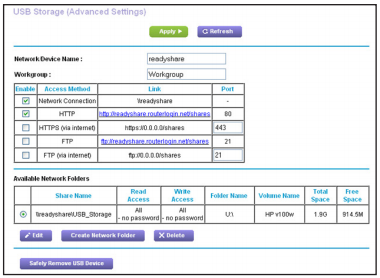
5. Click the Create Network Folder button.
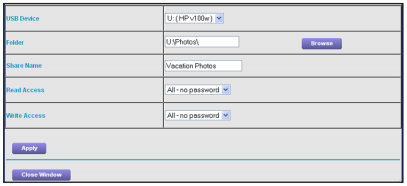
If this page does not display, your web browser might be blocking pop-ups. If it is, change the browser settings to allow pop-ups.
6. In the USB Device menu, select the USB drive.
7. Click the Browse button and in the Folder field, select the folder.
8. In the Share Name field, type the name of the share.
9. In the Read Access menu and the Write Access menu, select the settings that you want.
The user name (account name) for All–no password is guest. The password for admin is the same one that is used to log in to the router. By default, it is password.
10. Click the Apply button.
The folder is added on the USB device.
Edit a Network Folder on a USB Drive
You can add network folders on the USB storage device.
⮚ To edit a network folder:
1. Launch an Internet browser from a computer or wireless device that is connected to the network.
2. Type http://www.routerlogin.net or http://www.routerlogin.com.
A login window opens.
3. Enter the router user name and password.
The user name is admin. The default password is password. The user name and password are case-sensitive.
The BASIC Home page displays.
The Edit Network Folder page displays the same settings shown in the Add a Network Folder page.
4. Select ADVANCED > USB Functions > ReadySHARE Storage.
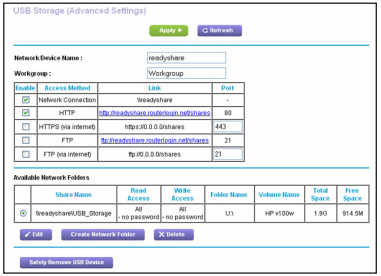
5. Click the Edit button.
6. Change the settings in the fields as needed.
7. Click the Apply button.
Your changes are saved.
Safely Remove a USB Drive
Before you physically disconnect a USB drive from the router USB port, log in to the router and take the drive offline.
⮚To remove a USB disk drive safely:
- Launch an Internet browser from a computer or wireless device that is connected to the network.
- Type http://www.routerlogin.net or http://www.routerlogin.com.
A login window opens. - Enter the router user name and password.
The user name is admin. The default password is password. The user name and password are case-sensitive.
The BASIC Home page displays. - Select ADVANCED > USB Functions > ReadySHARE Storage.
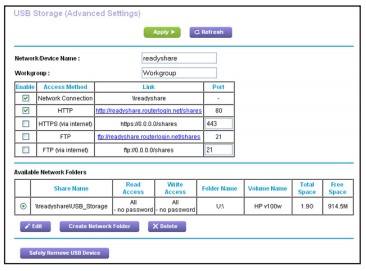
5. Click the Safely Remove USB Device button.
This takes the drive offline.
6. Physically disconnect the USB drive
Access the Router’s USB Drive Through the Internet
With Dynamic DNS, you can use the Internet to access a USB hard drive attached to the router’s USB port router when you’re not home. This chapter includes the following sections:
• Access the USB Drive Through the Internet
• Dynamic DNS
• Your Personal FTP Server
• Set Up Your Personal FTP Server
• Remotely Access a USB Device Using ReadyCLOUD
For information about how to connect the USB drive and to specify its settings, see Chapter 6, Share USB Storage Devices Attached to the Router
Access the USB Drive Through the Internet
You can access the USB drive through the Internet when you’re not home.
⮚ To access the USB drive from a remote computer:
Launch a web browser on a computer that is not on your home network.
Connect to your home router:
• To connect with Dynamic DNS, type the DNS name.
To use a Dynamic DNS account, you must enter the account information in the Dynamic DNS page. See Dynamic DNS on page 85.
• To connect without Dynamic DNS, type the router’s Internet port IP address.
You can view the router’s Internet IP address on the BASIC Home page.
You can use FTP to share files on a USB drive connected to the router.
Set Up FTP Access Through the Internet
⮚ To set up FTP access:
- Launch an Internet browser from a computer or wireless device that is connected to the network.
2. Type http://www.routerlogin.net or http://www.routerlogin.com.
A login window opens.
3. Enter the router user name and password.
The user name is admin. The default password is password. The user name and password are case-sensitive.
The BASIC Home page displays.
4. Select ADVANCED > USB Functions > ReadySHARE Storage.
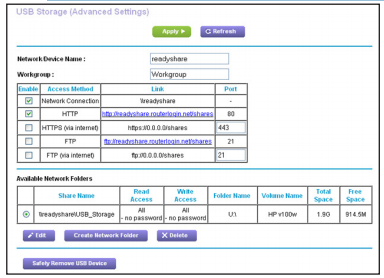
5. Select the FTP (via Internet) check box.
6. Click the Apply button.
Your changes are saved.
7. To limit access to the admin user, click the Edit button.

8. In the Read Access menu, select admin.
9. In the Write Access menu, select admin.
10. Click the Apply button.
Your changes are saved.
Access the USB Drive Through the Internet with FTP
You must first set up FTP through Internet access as described in access the USB Drive through the Internet with FTP8.
⮚ To access the USB drive with FTP from a remote computer:
- To download, launch an Internet browser.
2. To upload, use an FTP client such as filezilla.
3. Type ftp:// and the Internet port IP address in the address field of the browser.
For example, type ftp://10.1.65.4.
If you are using Dynamic DNS, type the DNS name.
For example, type ftp://MyName.mynetgear.com.
4. When prompted, log in.
• To log in as admin, in the user name field, type admin and in the password field, type the same password that you use to log in to the router.
• To log in as guest, in the user name field, enter guest.
The guest user name does not require a password. To restrict access to the USB drive, you can specify that only the admin user can access it. See Control Access to
the USB Drive.
The files and folders of the USB drive that your account can access to display. For example, you might see share/partition1/directory1.
Dynamic DNS
Internet service providers (ISPs) assign numbers called IP addresses to identify each Internet account. Most ISPs use dynamically assigned IP addresses. This means that the IP
address can change at any time. You can use the IP address to access your network remotely, but most people don’t know what their IP addresses are or when this number
changes.
To make it easier to connect, you can get a free account with a Dynamic DNS service that lets you use a domain name to access your home network. To use this account, you must set
up the router to use Dynamic DNS. Then the router notifies the Dynamic DNS service provider whenever its IP address changes. When you access your Dynamic DNS account,
the service finds the current IP address of your home network and automatically connects you.
If your ISP assigns a private WAN IP address (such as 192.168.x.x or 10.x.x.x), the Dynamic DNS service does not work because private addresses are not routed on the Internet.
Your Personal FTP Server
With your customized free URL, you can use FTP to access your network through Dynamic DNS when you aren’t home. To set up your FTP server, you must register for a free
NETGEAR Dynamic DNS (DDNS) service account and specify the account settings in the router’s Dynamic DNS page.
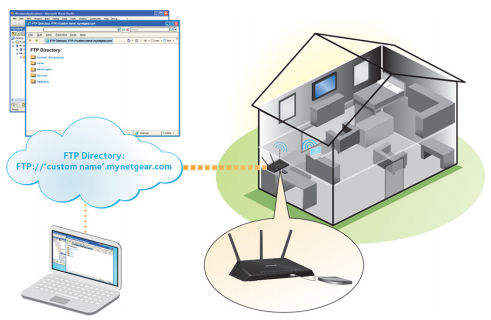
Note: The router supports only basic DDNS, and the login and password might not be secure. You can use DDNS with a VPN tunnel for a secure connection.
Set Up a New Dynamic DNS Account
⮚ To set up Dynamic DNS and register for a free NETGEAR account:
- Launch an Internet browser from a computer or wireless device that is connected to the
network. - Type http://www.routerlogin.net or http://www.routerlogin.com.
A login window opens. - Enter the router user name and password.
The user name is admin. The default password is password. The user name and password are case-sensitive.
The BASIC Home page displays. - Select ADVANCED > Advanced Settings > Dynamic DNS
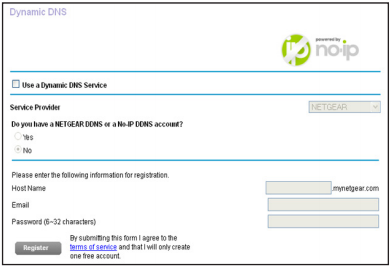
5. Select the Use a Dynamic DNS Service check box.
6. In the Service Provider menu, select NETGEAR.
7. Select the No radio button.
8. In the Host Name field, type the name that you want to use for your URL.
The host name is sometimes called the domain name. Your free URL includes the host name that you specify, and ends with mynetgear.com. For example, specify
MyName.mynetgear.com.
9. In the Email field, type the email address that you want to use for your account.
10. In the Password (6-32 characters) field, type the password for your account.
11. Click the Register button.
12. Follow the onscreen instructions to register for your NETGEAR Dynamic DNS service.
13. To check that Dynamic DNS is enabled in the router, click the Show Status button.
A message displays the Dynamic DNS status.
Specify a DNS Account
If you already use a Dynamic DNS account with NETGEAR, NO-IP, or Dyn, you can set up
the router to use your account.
⮚To set up Dynamic DNS:
- Launch an Internet browser from a computer or wireless device that is connected to the network.
2. Type http://www.routerlogin.net or http://www.routerlogin.com.
A login window opens.
3. Enter the router user name and password.
The user name is admin. The default password is password. The user name and
password are case-sensitive.
The BASIC Home page displays.
- Select ADVANCED > Advanced Settings > Dynamic DNS.
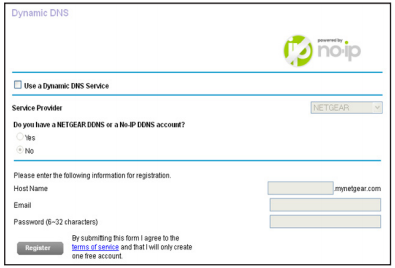
- Select the Use a Dynamic DNS Service check box.
- In the Service Provider menu, select one of the following:
• NETGEAR
• www.no-ip.com
• www.DynDNS.org - Select the Yes radio button.
The page adjusts and displays the Show Status, Cancel, and Apply buttons. - In the Host Name field, type the host name (sometimes called the domain name) for your account.
- For a No-IP or Dyn account, in the User Name field, enter the user name for your account.
- For a NETGEAR account at No-IP, in the Email field, type the email address for your account.
- In the Password (6-32 characters) field, type the password for your DDNS account.
- Click the Apply button.
Your changes are saved. - To verify that your Dynamic DNS service is enabled in the router, click the Show Status button.
A message displays the Dynamic DNS status.
Change the Dynamic DNS Settings
⮚ To change your settings:
- Launch an Internet browser from a computer or wireless device that is connected to the network.
2. Type http://www.routerlogin.net or http://www.routerlogin.com.
A login window opens.
3. Enter the router user name and password.
The user name is admin. The default password is password. The user name and password are case-sensitive.
The BASIC Home page displays.
4. Select ADVANCED > Advanced Settings > Dynamic DNS.
The Dynamic DNS page displays.
5. Change your DDNS account settings as necessary.
6. Click the Apply button.
Your changes are saved.
Set Up Your Personal FTP Server
⮚ To set up your personal account and use FTP:
- Get your free NETGEAR Dynamic DNS domain name.
See Your Personal FTP Server.
2. Make sure that your Internet connection is working.
Your router must use a direct Internet connection. It cannot connect to a different router to access the Internet.
3. Connect a USB hard disk drive to a USB port on the router.
4. Set up FTP access in the router.
See Set Up FTP Access Through the Internet.
On a remote computer with Internet access, you can use FTP to access your router using ftp://yourname.mynetgear.com.
5. On your WAN PC, you can FTP to your router using ftp://yourname.mynetgear.com.
Remotely Access a USB Device Using ReadyCLOUD
NETGEAR ReadyCLOUD for routers lets you remotely access files stored on a USB storage device that is connected to the router. Before you can use ReadyCLOUD, you must create a
ReadyCLOUD account and register your router.
A ReadyCLOUD app is also available for Windows computers, Android mobile devices, and iOS mobile devices. For more information about setting up ReadyCLOUD, see the
ReadyCLOUD for Routers User Manual, which is available online at http://downloadcenter.netgear.com.
Create a ReadyCLOUD Account
⮚ To create a ReadyCLOUD account:
- Launch a web browser from a computer or WiFi device.
- Visit http://readycloud.netgear.com.
The ReadyCLOUD Welcome page displays. - Click the Sign In link.
The Sign In page displays. - Click the Create Account link
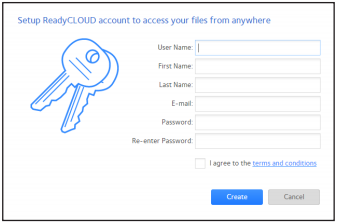
- Complete the fields to set up your account, and click the Create button.
You are now ready to register your router with your ReadyCLOUD account.
To register your router with your ReadyCLOUD account:
- Visit http://kb.netgear.com/app/answers/detail/a_id/27323/ and check to see if your router supports ReadyCLOUD.
- Connect a USB storage device to a USB port on the router.
If your USB storage device uses a power supply, you must use it when you connect the USB storage device to the router.
When you connect the USB storage device to the router’s USB port, it might take up to two minutes before it is ready for sharing. By default, the USB storage device is available to all
computers on your local area network (LAN). - Launch a web browser from a computer or WiFi device that is connected to the network.
- Type http://www.routerlogin.net.
A login window opens. - Enter the router user name and password.
The user name is admin. The default password is password. The user name and password are case-sensitive.
The BASIC Home page displays. - Select ReadySHARE.
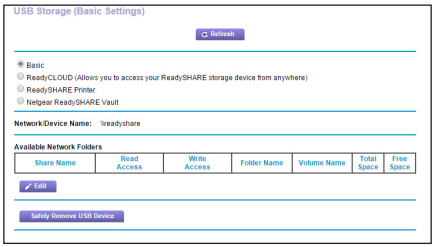
7. Select the ReadyCLOUD radio button.
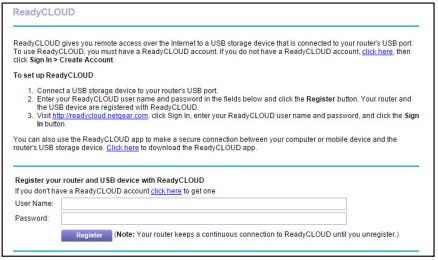
8. Enter your ReadyCLOUD user name and password and click the Register button. if you did not create a ReadyCLOUD account, see Create a ReadyCLOUD Account.
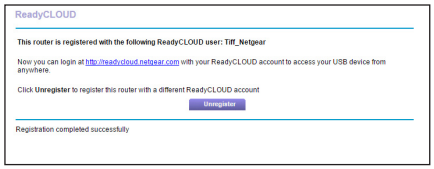
Note: If the router’s Internet connection mode is set to Dial on Demand, the router automatically changes the connection mode to Always On. This change is required for ReadyCLOUD to remotely access the USB storage device.
Use the Router as a Media Server
This chapter contains the following sections:
• Specify ReadyDLNA Media Server Settings
• Play Music from a USB Drive with iTunes Server
• Play Media from a USB Drive on TiVo
Specify ReadyDLNA Media Server Settings
By default, the router acts as a ReadyDLNA media server, which lets you view movies and photos on DLNA/UPnP AV-compliant media players, such as Xbox360, Playstation, and
NETGEAR media players.
⮚ To specify media server settings:
- Launch an Internet browser from a computer or wireless device that is connected to the network.
- Type http://www.routerlogin.net or http://www.routerlogin.com.
A login window opens. - Enter the router user name and password.
The user name is admin. The default password is password. The user name and password are case-sensitive.
The BASIC Home page displays. - Select ADVANCED > USB Functions > ReadySHARE Storage.
The USB Storage (Advanced Settings) page displays. - Select the Media Server tab.
The Media Server (Settings) page displays. - Specify the settings:
• Enable Media Server. Select this check box to enable this device to act as a media server.
• Enable TiVo support. Select this check box if you want to play ReadyNAS media on our TiVo device. See the Play Media from a USB Drive on TiVo on page 96.
• Media Server Device Name. Specify the name of the media server. - Click the Apply button.
Your changes are saved.
Play Music from a USB Drive with iTunes Server
iTunes Server lets you play music with your Windows or Mac iTunes app from a USB drive that is connected to the router USB port. You can also use the Apple Remote app from an iPhone or iPad to play music on any AirPlay devices, such as Apple TV or AirPlay-supported receivers.

Figure 11. Play music on a USB drive with iTunes
Supported music file formats are MP3, AAC, and FLAC. The maximum number of music files supported is 10,000.
⮚ To specify iTunes server settings:
- On your iPhone or iPad, find and connect to the WiFi network.
- Download the Remote app from the Apple App Store.
- Launch the Remote app from your iPhone or iPad.
The Remote page displays. - Click the Add a Device button.
A passcode displays. - Specify the router settings:
a. Launch an Internet browser from a computer or wireless device that is connected to the network.
b. Type http://www.routerlogin.net or http://www.routerlogin.com.
A login window opens.
c. Enter the router user name and password.
The user name is admin. The default password is password. The user name and password are case-sensitive.
The BASIC Home page displays. d. Select ADVANCED > USB Functions > ReadySHARE Storage > Media Server.

e. Select the Enable iTunes Media Server (Music Only) check box and click the Apply button.
f. Enter the passcode and click the Allow Control button.
Your changes take effect.
On your iPhone or iPad, the ReadySHARE music library displays in the Remote app. you can play this music to AirPlay devices
Play Media from a USB Drive on TiVo
You can set up your TiVo to access media files stored on a USB device that is connected to your router. The TiVo must be on the same network as the router. This feature supports the
following file formats:
• Video. See and play mpeg1, and mpeg2 files.
• Music. See and play MP3 files.
• Pictures. View images in jpg format.
You can use the TiVo (Series 2 and up) Home Media Option to play photos and music on your Windows or Mac computer in your TiVo user interface.
⮚ To set up the router to work with TiVo:
- Launch an Internet browser from a computer or wireless device that is connected to the network.
- Type http://www.routerlogin.net or http://www.routerlogin.com.
A login window opens. - Enter the router user name and password. The user name is admin. The default password is password. The user name and password are case-sensitive.
The BASIC Home page displays.
4. Select ADVANCED > USB Functions > ReadySHARE Storage.
The USB Storage (Advanced Settings) page displays.
5. Select the Media Server tab.
The Media Server (Settings) page displays.
6. Make sure that the Enable TiVo support check box is selected.
⮚ To play videos:
- On the TiVo, select TiVo Central > My Shows
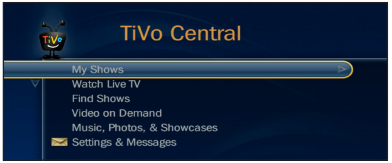
2. At the bottom of the page, select the R6400.
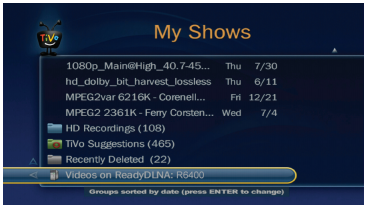
To play music or view photos:
- On the TiVo, select TiVo Central > Music, Photos, & Showcases.

To play music or view photos:
- On the TiVo, select TiVo Central > Music, Photos, & Showcases.
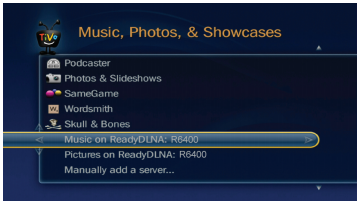
2. Select an item to play or watch.
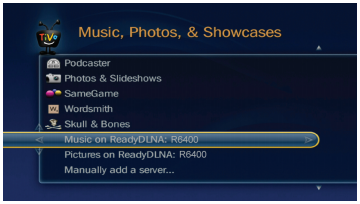
⮚To copy TiVo files to a computer:
Use the TiVo Desktop accessory, available at https://www3.tivo.com/store/accessories-software.do.
Share A USB Printer
The ReadySHARE Printer utility lets you share a USB printer that is connected to a USB port on your router. You can share this USB printer among the Windows and Mac computers on your network.
Note: NETGEAR recommends that you connect a printer to the USB 2.0-Printer port on the rear panel of the router.
This chapter contains the following sections:
• Install the Printer Driver and Cable the Printer
• Download the ReadySHARE Printer Utility
• Install the ReadySHARE Printer Utility
• Use the Shared Printer
• View or Change the Status of a Printer
• Use the Scan Feature of a Multifunction USB Printer
• Change NETGEAR USB Control Center Settings
Install the Printer Driver and Cable the Printer
Some USB printer manufacturers (for example, HP and Lexmark printers) request that you do not connect the USB cable until the installation software prompts you to do so.
⮚ To install the driver and cable the printer:
- On each computer on your network that shares the USB printer, install the driver software for the USB printer. If you cannot find the printer driver, contact the printer manufacturer.
- Use a USB printer cable to connect the USB printer to the router USB port.

Download the ReadySHARE Printer Utility
The utility works on Windows and Mac computers.
⮚ To download the utility:
- Visit www.netgear.com/readyshare.
- Scroll down to the Print From the Comfort of Your Home Network section at the bottom of the page.
- Click one of the following links.
• Download PC installer and get started. This is the utility for Windows computers.
• Download Mac installer and get started. This is the utility for MAC computers. - Follow the onscreen instructions to download the ReadySHARE Printer utility setup file and install.
Install the ReadySHARE Printer Utility
You must install the ReadySHARE Printer utility on each computer that will share the printer.
After you install it, the utility displays as NETGEAR USB Control Center on your computer.
⮚To install the utility:
- Double-click the ReadySHARE Printer utility setup file that you downloaded.
The InstallShield wizard displays.
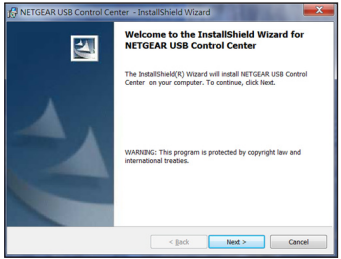
- Follow the wizard instructions to install NETGEAR USB Control Center.
After the InstallShield Wizard completes the installation, the NETGEAR USB Control Center prompts you to select a language:
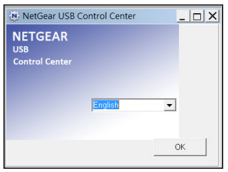
3. Select a language from the list and click the OK button.

Some firewall software, such as Comodo, blocks NETGEAR USB Control Center from accessing the USB printer. If you do not see the USB printer displayed, you can disable
the firewall temporarily to allow the utility to work.
- Select the printer and click the Connect button.
The printer status changes to Manually connected by Mycomputer. Now, only your computer can use the printer. - Click the Disconnect button.
The status changes to Available. Now all computers on the network can use the printer. - To exit the utility, select System > Exit.
Use the Shared Printer
For each computer, after you click the Connect and Disconnect buttons once, the utility automatically manages the printing queue and handling. By default, the utility starts
automatically whenever you log on to Windows and runs in the background.
⮚ To manually connect and print:
- Click the NETGEAR USB Control Center icon .
The main page displays.
2. Click the Connect button.
The printer status changes to Manually connected by Mycomputer. Now, only the computer you are using can use this printer.
3. Use the print feature in your application to print your document.
4. To release the printer so that all computers on the network can use it, click the Disconnect
button.
⮚To print and release the printer to any computer on the network:
- To print your document, use the print feature in your application.
The NETGEAR USB Control Center automatically connects your computer to the USB printer and prints the document. If another computer is already connected to the printer,
your print job goes into a queue to wait to be printed. - If your document does not print, use the NETGEAR USB Control Center to check the status.
View or Change the Status of a Printer
⮚ To view or change the status:
- Click the NETGEAR USB Control Center icon

The Status column shows the status for each device:
• Available. No print jobs are in process. You can use the USB printer from any computer in the network.
• Connected. Your computer is connected to the printer and will be released when your print job is done.
• Manually Connected by. Only the connected computer can use the printer.
• Waiting to Connect. Your computer is not connected to the shared printer yet.
- To print from your computer when the status shows Manually connected by to another
computer, click the Disconnect button.
The printer is released from the connection and the status changes to Available. - To print from your computer when the status shows Waiting to Connect:
a. Click the Connect button.
The printer status changes to Manually connected by Mycomputer. Now, only your
computer can use the printer.
b. To allow the printer to be shared, click the Disconnect button.
The printer is released from the connection and the status changes to Available.
Use the Scan Feature of a Multifunction USB Printer
If your USB printer supports scanning, you can also use the USB printer for scanning.
⮚ To use the scan feature of a multifunction USB printer:
- Launch the NETGEAR USB Control Center.
- Make sure that the printer status shows as Available.
- Click the Network Scanner button.
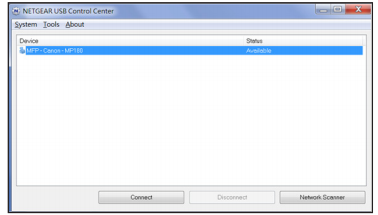
The scanner page displays so that you can use the USB printer for scanning.
Change NETGEAR USB Control Center Settings
You can stop the NETGEAR USB Control Center from starting automatically when you log in to Windows. You can also change the language and specify the time-out to release the
printer connection.
⮚ To turn off automatic NETGEAR USB Control Center startup:
- Select Tools > Configuration.
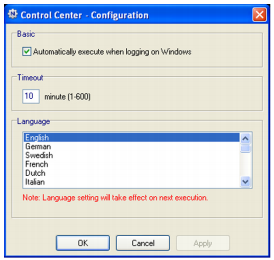
Clear the Automatically execute when logging on Windows check box.
- Click the OK button.
Your change is saved.
⮚ To change the language:
- Select Tools > Configuration.
2. In the Language list, select a language.
3. Click the OK button.
The next time NETGEAR USB Control Center starts, the language changes.
⮚ To specify the time-out:
- Select Tools > Configuration.
2. In the Timeout field, type the number of minutes.
The time-out is the number of minutes that a computer holds its connection to the printer when the connection isn’t being used.
3. Click the OK button.
Your change is saved.
Specify Network Settings
This chapter includes the following sections:
• Disable LED Blinking or Turn Off LEDs
• View the WAN Settings
• Set Up a Default DMZ Server
• Change the Router’s Device Name
• Change the LAN TCP/IP Settings
• Specify the IP Addresses That the Router Assigns
• Disable the DHCP Server Feature in the Router
• Manage Reserves LAN IP Addresses
• Use the WPS Wizard for WiFi Connections
• Specify Basic WiFi Settings
• Change the WiFi Security Option
• Set Up a Guest Network
• How the Router Manages WiFi Clients
• Control the Wireless Radios
• Set Up a Wireless Schedule
• Specify WPS Settings
• Set Up the Router with an Existing Router or Gateway
• Use the Router as a Wireless Access Point
• Set Up the Router in Bridge Mode
Disable LED Blinking or Turn Off LEDs
The router LEDs on the top panel indicate router activities and behavior. You can disable LED blinking for network communications, or turn off all LEDs except the Power LED.
⮚To disable LED blinking or turn off the LEDs:
- Launch an Internet browser from a computer or wireless device that is connected to the network.
- Type http://www.routerlogin.net or http://www.routerlogin.com.
A login window opens. - Enter the router user name and password.
The user name is admin. The default password is password. The user name and password are case-sensitive.
The BASIC Home page displays. - Select ADVANCED > Advanced Setup > LED Control Settings.

By default, the Enable blinking on Internet LED, LAN LED, Wireless LED, and USB LED when data traffic is detected radio button is selected, which allows standard LED
behavior. For information about standard LED behavior, see Table 1, LED and button descriptions.
- To disable blinking, select the Disable blinking on Internet LED, LAN LED, Wireless LED, and USB LED when data traffic is detected radio button.
- To turn off the LEDs, select the Turn off all LEDs except Power LED radio button.
- Click the Apply button.
Your change takes effect.
View the WAN Settings
You can view or configure wide area network (WAN) settings for the Internet port. You can set up a DMZ (demilitarized zone) server, change the maximum transmit unit (MTU) size, and
enable the router to respond to a ping to its WAN (Internet) port.
⮚To view the the WAN settings:
- Launch an Internet browser from a computer or wireless device that is connected to the network.
- Type http://www.routerlogin.net or http://www.routerlogin.com.
A login window opens. - Enter the router user name and password.
The user name is admin. The default password is password. The user name and password are case-sensitive.
The BASIC Home page displays. - Select ADVANCED > Setup > WAN Setup.
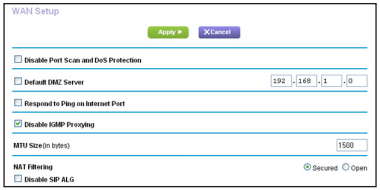
The following settings display:
• Disable Port Scan and DoS Protection. DoS protection protects your LAN against denial of service attacks such as Syn flood, Smurf Attack, Ping of Death, and many
others. Select this check box only in special circumstances.
• Default DMZ Server. This feature is sometimes helpful when you are playing online games or videoconferencing, but it makes the firewall security less effective. See Set
Up a Default DMZ Server on page 109.
• Respond to Ping on Internet Port. This feature allows your router to be discovered. Use this feature only as a diagnostic tool or for a specific reason.
• Disable IGMP Proxying. IGMP proxying allows a computer on the local area network (LAN) to receive the multicast traffic it is interested in from the Internet. If you do not
need this feature, you can select this check box to disable it.
• MTU Size (in bytes). The normal MTU (maximum transmit unit) value for most Ethernet networks is 1500 bytes, or 1492 bytes for PPPoE connections. Change the
MTU only if you are sure that it is necessary for your ISP connection. See Change the MTU Size.
• NAT Filtering. Network Address Translation (NAT) determines how the router processes inbound traffic. Secured NAT protects computers on the LAN from attacks
from the Internet, but might prevent some Internet games, point-to-point applications, or multimedia applications from working. Open NAT provides a much less secured
firewall, but allows almost all Internet applications to work.
. Disable SIP ALG. Some voice or video communication applications do not work well with SIP ALG. Disabling SIP ALG might help your voice or video applications to create
or accept a call through the router.
- Click the Apply button.
Your changes are saved.
Set Up a Default DMZ Server
The default DMZ server feature is helpful when you are using some online games and videoconferencing applications that are incompatible with Network Address Translation
(NAT). The router is programmed to recognize some of these applications and to work correctly with them, but other applications might not function well. In some cases, one local
computer can run the application correctly if the IP address for that computer is entered as the default DMZ server.
WARNING:
DMZ servers pose a security risk. A computer designated as the default DMZ server loses much of the protection of the firewall and is exposed to exploits from the Internet. If compromised, the DMZ server computer can be used to attack other computers on your network.
The router usually detects and discards incoming traffic from the Internet that is not a response to one of your local computers or a service that you configured in the Port
Forwarding/Port Triggering page. Instead of discarding this traffic, the router can forward the raffic to one computer on your network. This computer is called the default DMZ server.
⮚ To set up a default DMZ server:
- Launch an Internet browser from a computer or wireless device that is connected to the network.
- Type http://www.routerlogin.net or http://www.routerlogin.com.
A login window opens. - Enter the router user name and password.
The user name is admin. The default password is password. The user name and password are case-sensitive.
The BASIC Home page displays. - Select ADVANCED > Setup > WAN Setup.
The WAN Setup page displays. - Select the Default DMZ Server check box.
- Type the IP address.
- Click the Apply button. Your change takes effect.
Change the Router’s Device Name
The router’s device name is R6400. This device name displays in a file manager when you
browse your network.
⮚ To change the router’s device name:
- Launch an Internet browser from a computer or wireless device that is connected to the network.
- Type http://www.routerlogin.net or http://www.routerlogin.com.
A login window opens. - Enter the router user name and password.
The user name is admin. The default password is password. The user name and password are case-sensitive.
The BASIC Home page displays. - Select ADVANCED > Setup > LAN Setup.
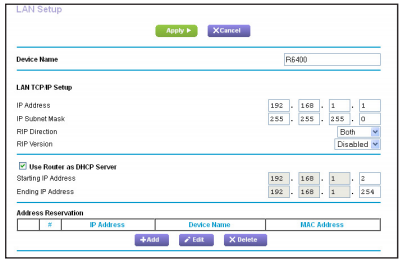
5. In the IP Address field, type the IP address.
- In the IP Subnet Mask field, type the subnet mask of the router.
The IP address and subnet mask identify which addresses are local to a specific device and which must be reached through a gateway or router. - Change the RIP settings.
Router Information Protocol (RIP) allows a router to exchange routing information with other routers.
a. In the RIP Direction menu, select one of the following:
- Both. The router broadcasts its routing table periodically and incorporates information that it receives.
- Out Only. The router broadcasts its routing table periodically.
- In Only. The router incorporates the RIP information that it receives.
b. In the RIP Version menu, select one of the following: - Disabled. This is the default setting.
- RIP-1. This format is universally supported. It is adequate for most networks,
unless your network setup is unusual. - RIP-2. This format carries more information. Both RIP-2B and RIP-2M send the
routing data in RIP-2 format. RIP-2B uses subnet broadcasting. RIP-2M uses
multicasting.
8. Click the Apply button.
Your changes are saved.
If you changed the LAN IP address of the router, you are disconnected when this change
takes effect.
9. To reconnect, close your browser, relaunch it, and log in to the router
Specify the IP Addresses That the Router Assigns
By default, the router acts as a Dynamic Host Configuration Protocol (DHCP) server. The
router assigns IP, DNS server, and default gateway addresses to all computers connected to the LAN. The assigned default gateway address is the LAN address of the router.
These addresses must be part of the same IP address subnet as the router’s LAN IP address. Using the default addressing scheme, define a range between 192.168.1.2 and
192.168.1.254, although you can save part of the range for devices with fixed addresses.
⮚ To specify the pool of IP addresses that the router assigns:
- Launch an Internet browser from a computer or wireless device that is connected to the network.
- Type http://www.routerlogin.net or http://www.routerlogin.com.
A login window opens. - Enter the router user name and password.
The user name is admin. The default password is password. The user name and password are case-sensitive.
The BASIC Home page displays. - Select ADVANCED > Setup > LAN Setup.
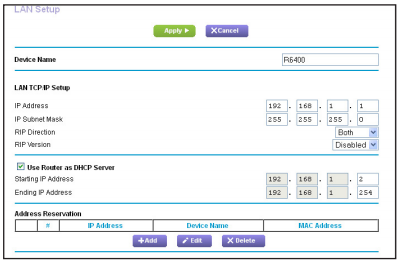
- Make sure that the Use Router as DHCP Server check box is selected.
- Specify the range of IP addresses that the router assigns:
a. In the Starting IP Address field, type the lowest number in the range.
This IP address must be in the same subnet as the router.
b. In the Ending IP Address field, type the number at the end of the range of IP addresses.
This IP address must be in the same subnet as the router. - Click the Apply button.
Your settings are saved.
The router delivers the following parameters to any LAN device that requests DHCP:
• An IP address from the range that you defined
• Subnet mask
• Gateway IP address (the router’s LAN IP address)
• DNS server IP address (the router’s LAN IP address)
Disable the DHCP Server Feature in the Router
By default, the router acts as a DHCP server. The router assigns IP, DNS server, and default gateway addresses to all computers connected to the LAN. The assigned default gateway
address is the LAN address of the router.
You can use another device on your network as the DHCP server, or specify the network settings of all your computers.
⮚To disable the DHCP server feature in the router:
- Launch an Internet browser from a computer or wireless device that is connected to the network.
- Type http://www.routerlogin.net or http://www.routerlogin.com.
A login window opens. - Enter the router user name and password.
The user name is admin. The default password is password. The user name and password are case-sensitive.
The BASIC Home page displays. - Select ADVANCED > Setup > LAN Setup.
The LAN Setup page displays. - Clear the Use Router as DHCP Server check box.
- Click the Apply button.
- (Optional) If this service is disabled and no other DHCP server is on your network, set your computer IP addresses manually so that they can access the router.
Manage Reserves LAN IP Addresses
When you specify a reserved IP address for a computer on the LAN, that computer always
receives the same IP address each time it accesses the router’s DHCP server. Assign
reserved IP addresses to computers or servers that require permanent IP settings.
Reserve an IP Address
⮚ To reserve an IP address:
- Launch an Internet browser from a computer or wireless device that is connected to the network.
2. Type http://www.routerlogin.net or http://www.routerlogin.com.
A login window opens.
3. Enter the router user name and password.
The user name is admin. The default password is password. The user name and password are case-sensitive.
The BASIC Home page displays.
4. Select ADVANCED > Setup > LAN Setup.
The LAN Setup page displays.
5. In the Address Reservation section, click the Add button.
6. In the IP Address field, type the IP address to assign to the computer or server.
Choose an IP address from the router’s LAN subnet, such as 192.168.1.x.
- Type the MAC address of the computer or server.
Tip: If the computer is already on your network, you can copy its MAC address from the Attached Devices page and paste it here. - Click the Apply button.
The reserved address is entered into the table.
The reserved address is not assigned until the next time the computer contacts the router’s
DHCP server. Reboot the computer, or access its IP configuration and force a DHCP release and renew.
Edit a Reserved IP Address Entry
⮚To edit a reserved address entry:
- Launch an Internet browser from a computer or wireless device that is connected to the network.
- Type http://www.routerlogin.net or http://www.routerlogin.com.
A login window opens. - Enter the router user name and password.
The user name is admin. The default password is password. The user name and password are case-sensitive.
The BASIC Home page displays. - Select ADVANCED > Setup > LAN Setup.
The LAN Setup page displays. - In the Address Reservation section, select the radio button next to the reserved address.
- Click the Edit button.
- Change the settings.
- Click the Apply button.
Your changes are saved.
Delete a Reserved IP Address Entry
⮚To delete a reserved address entry:
- Launch an Internet browser from a computer or wireless device that is connected to the network.
2. Type http://www.routerlogin.net or http://www.routerlogin.com.
A login window opens.
3. Enter the router user name and password.
The user name is admin. The default password is password. The user name and password are case-sensitive.
The BASIC Home page displays.
4. Select ADVANCED > Setup > LAN Setup.
The LAN Setup page displays.
5. In the Address Reservation section, select the radio button next to the reserved address.
6. Click the Delete button.
The address is removed.
Use the WPS Wizard for WiFi Connections
The WPS Wizard helps you add a wireless computer or device to your WiFi network without
typing the WiFi password.
⮚ To use the WPS Wizard:
- Launch an Internet browser from a computer or wireless device that is connected to the network.
- Type http://www.routerlogin.net or http://www.routerlogin.com.
A login window opens. - Enter the router user name and password.
The user name is admin. The default password is password. The user name and password are case-sensitive.
The BASIC Home page displays. - Select ADVANCED > WPS Wizard.
A page displays information about WPS. - Click the Next button.
- Select the radio button for a setup method:.
• Push button. Click the WPS button on this page.
• PIN Number. The page adjusts. Enter the client security PIN, and click the Next button. - Within two minutes, go to the client device and use its WPS software to connect to the WiFi network.
The WPS process automatically sets up your wireless computer with the network password when it connects. The router WPS page displays a confirmation message.
Specify Basic WiFi Settings
The router comes with preset security. This means that the WiFi network name (SSID), network key (password), and security option (encryption protocol) are preset in the factory.
You can find the preset SSID and password on the router label.
Note: The preset SSID and password are uniquely generated for every device to protect and maximize your wireless security.
NETGEAR recommends that you do not change your preset security settings. If you change our preset security settings, make a note of the new settings and store it in a safe place
where you can easily find it.
If you use a wireless computer to change the SSID or other wireless security settings, you are disconnected when you click the Apply button. To avoid this problem, use a computer with
a wired connection to access the router.
⮚ To specify basic wireless settings:
- Launch an Internet browser from a computer or wireless device that is connected to the network.
- Type http://www.routerlogin.net or http://www.routerlogin.com.
A login window opens. - Enter the router user name and password.
The user name is admin. The default password is password. The user name and password are case-sensitive.
The BASIC Home page displays. - Select Wireless.
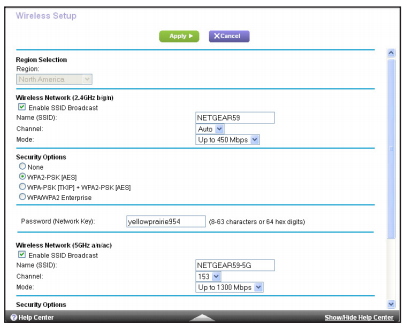
5. In the Region menu, select your region.
In some locations, you cannot change this setting.
- To control the SSID broadcast, select or clear the Enable SSID Broadcast check box.
When this check box is selected, the router broadcasts its network name (SSID) so that it displays when you scan for local WiFi networks on your computer or wireless device. - To change the SSID, type a new name in the Name (SSID) field.
The name can be up to 32 characters long and it is case-sensitive. The default SSID is randomly generated and is on the router’s label. If you change the name, make sure to
write down the new name and keep it in a safe place. - To change the wireless channel, select a number in the Channel menu.
In some regions, not all channels are available. Do not change the channel unless you experience interference (shown by lost connections or slow data transfers). If this
happens, experiment with different channels to see which is the best.
When you use multiple access points, it is better if adjacent access points use different channels to reduce interference. The recommended channel spacing between adjacent
access points is four channels (for example, use Channels 1 and 5, or 6 and 10). - To change the mode, select it from the Mode menu.
For 2.4 GHz, Up to 450 Mbps is the default setting.
For 5 GHz, Up to 1300 Mbps is the default setting, which allows 802.11ac and 802.11a wireless devices to join the network. - Click the Apply button.
Your settings are saved.
If you connected wirelessly to the network and you changed the SSID, you are disconnected from the network.
- Make sure that you can connect wirelessly to the network with its new settings.
If you cannot connect wirelessly, check the following:
• Is your computer or wireless device connected to another wireless network in your area? Some wireless devices automatically connect to the first open network without
wireless security that they discover.
• Is your computer or wireless device trying to connect to your network with its old settings (before you changed the settings)? If so, update the wireless network
selection in your computer or wireless device to match the current settings for your network.
Change the WiFi Security Option
Your router comes with preset WPA2 or WPA security. The password that you enter to connect to your network is unique to your router and is on the router label. NETGEAR
recommends that you use the preset security, but you can change the settings. NETGEAR recommends that you do not disable security.
⮚ To change the WPA settings:
- Launch an Internet browser from a computer or wireless device that is connected to the network.
- Type http://www.routerlogin.net or http://www.routerlogin.com.
A login window opens. - Enter the router user name and password.
The user name is admin. The default password is password. The user name and password are case-sensitive.
The BASIC Home page displays. - Select Wireless.
- Under Security Options, select a WPA option:
• WPA-PSK [TKIP]
• WPA2-PSK [AES]
• WPA-PSK [TKIP] + WPA2-PSK [AES]
• WPA/WPA2 Enterprise
The WPA2 options use the newest standard for the strongest security, but some older computers and wireless devices cannot use WPA2. By default, the WPA-PSK [TKIP] +
WPA2-PSK [AES] radio button is selected so that new or old computers and wireless devices can connect to the WiFi network by using either WPA2 or WPA security.
The Password (Network Key) field displays.
- In the Password (Network Key) field, enter a password.
It is a text string from 8 to 63 characters. - Write down the new password and keep it in a secure place for future reference.
- Click the Apply button.
Your changes are saved.
Set Up a Guest Network
A guest network allows visitors at your home to use the Internet without using your wireless security key. You can add a guest network to each wireless network: 2.4 GHz b/g/n and
5.0 GHz a/n.
⮚ To set up a guest network:
- Launch an Internet browser from a computer or wireless device that is connected to the network.
- Type http://www.routerlogin.net or http://www.routerlogin.com.
A login window opens. - Enter the router user name and password.
The user name is admin. The default password is password. The user name and password are case-sensitive.
The BASIC Home page displays. - Select Guest Network.
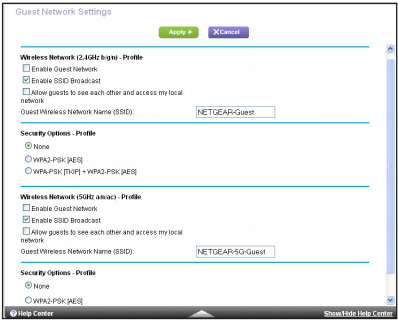
- Select any of the following wireless settings:
• Enable Guest Network. When this check box is selected, the guest network is enabled, and guests can connect to your network using the SSID of this profile.
• Enable SSID Broadcast. If this check box is selected, the wireless access point broadcasts its name (SSID) to all wireless stations. Stations with no SSID can adopt
the correct SSID for connections to this access point.
• Allow guest to see each other and access my local network. If this check box is selected, anyone who connects to this SSID can access your local network, not just
the Internet. - Give the guest network a name. che guest network name is case-sensitive and can be up to 32 characters. You then manually configure the wireless devices in your network to use the guest network name
in addition to the main SSID. - Select a radio button for a security option.
The WPA2 options use the newest standard for the strongest security, but some older computers and wireless devices cannot use it. NETGEAR recommends that you select
the WPA-PSK [TKIP] + WPA2-PSK [AES] radio button. This setting protects your WiFi network and lets computers and wireless devices connect to the WiFi network by using
either WPA2 or WPA security. - Click the Apply button.
Your settings are saved.
How the Router Manages WiFi Clients
A WiFi client is any computer or WiFi device that connects to the router’s WiFi network. The router uses airtime fairness and implicit beamforming to manage its wireless clients. These
features are enabled by default, but you can disable them.
Airtime Fairness
Airtime fairness ensures that all clients receive equal time on the network. Network resources are divided by time, so if five clients connect to the router, they each get one-fifth of the network time. The advantage of this feature is that your slowest clients don’t control network responsiveness. This feature is enabled by default, but you can disable it.
⮚ To disable Airtime fairness:
- Launch an Internet browser from a computer or wireless device that is connected to the network.
- Type http://www.routerlogin.net or http://www.routerlogin.com.
A login window opens. - Enter the router user name and password.
The user name is admin. The default password is password. The user name and password are case-sensitive.
The BASIC Home page displays. - Select ADVANCED > Advanced Setup > Wireless Settings.
The Wireless Settings page displays. - Scroll down below the WPS Settings section of the page and clear the Enable AIRTIME
FAIRNESS check box. - Click the Apply button.
Your settings are saved.
Implicit Beamforming
Implicit beamforming contrasts with explicit beamforming, which means that your router actively tracks clients and directs power to the router antenna closest to the client. This works
whether or not the client supports beamforming. Implicit beamforming means that the router can use information from client devices that support beamforming to improve the WiFi signal.
This feature is enabled by default, but you can disable it.
⮚ To disable implicit beamforming:
- Launch an Internet browser from a computer or wireless device that is connected to the network.
2. Type http://www.routerlogin.net or http://www.routerlogin.com.
A login window opens.
- Enter the router user name and password.
The user name is admin. The default password is password. The user name and password are case-sensitive.
The BASIC Home page displays. - Select ADVANCED > Advanced Setup > Wireless Settings
- Scroll down below the WPS Settings section of the page and clear the Enable Implicit BEAMFORMING check box.
- Click the Apply button. Your settings are saved.
Control the Wireless Radios
The router’s internal wireless radios broadcast signals in the 2.4 GHz and 5 GHz range. By default, the radios are on so that you can connect wirelessly to the router. When the wireless
radios are off, you can still use an Ethernet cable for a LAN connection to the router.
You can turn the wireless radios on and off with the WiFi On/Off button on the router, or you can log in to the router and enable or disable the wireless radios. If you are close to the
router, it might be easier to press its WiFi On/Off button. If you are away from the router or you already logged in, it might be easier to enable or disable the radios. You can also turn
them off and on based on a schedule. (See Set Up a Wireless Schedule
Use the WiFi On/Off Button
⮚ To turn the wireless radios off and on with the WiFi On/Off button:
Press the WiFi On/Off button on the top of the router for two seconds.
If you turned off the wireless radios, the WiFi On/Off LED and the WPS LED turn off. If you turned on the wireless radios, the WiFi On/Off LED and the WPS LED light.
Enable or Disable the Wireless Radios
If you used the WiFi On/Off button to turn off the wireless radios, you can’t log in to the router o turn them back on. You must press the WiFi On/Off button again for two seconds to turn
the wireless radios back on.
⮚ To enable or disable the wireless radios:
- Launch an Internet browser from a computer or wireless device that is connected to the network.
- Type http://www.routerlogin.net or http://www.routerlogin.com.z
If you used the WiFi On/Off button to turn off the wireless radios, you can’t log in to the router
to turn them back on. You must press the WiFi On/Off button again for two seconds to turn
the wireless radios back on.
To enable or disable the wireless radios:
A login window opens.
- Enter the router user name and password.
The user name is admin. The default password is password. The user name and
password are case-sensitive.
The BASIC Home page displays. - Select ADVANCED > Advanced Setup > Wireless Settings.
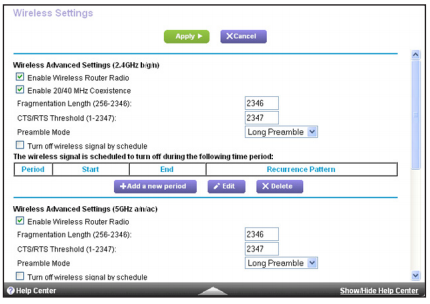
- Select or clear the Enable Wireless Radio check boxes in the 2.4 GHz and 5 GHz sections.
Clearing these check boxes turns off the WiFi feature of the router. - Click the Apply button.
If you turned off both wireless radios, the WiFi On/Off LED and the WPS LED turn off. If you turned on the wireless radios, the WiFi On/Off LED and the WPS LED light.
Set Up a Wireless Schedule
You can turn off the WiFi signal from your router at times when you do not need a wireless connection. For example, you might turn it off for the weekend if you leave town.
⮚ To set up the wireless schedule:
- Launch an Internet browser from a computer or wireless device that is connected to the network.
- Type http://www.routerlogin.net or http://www.routerlogin.com.
A login window opens. - Enter the router user name and password.
The user name is admin. The default password is password. The user name and password are case-sensitive.
The BASIC Home page displays.
4. Select ADVANCED > Advanced Setup > Wireless Settings.
The Advanced Wireless Settings page displays.
5. Click the Add a new period button.

- Use the menus, radio buttons, and check boxes to set up a period during which you want to turn off the wireless signal.
- Click the Apply button.
The Advanced Wireless Settings page displays.
8. Select the Turn off wireless signal by schedule check box to activate the schedule.
9. Click the Apply button.
Your settings are saved.
Specify WPS Settings
Wi-Fi Protected Setup (WPS) lets you join the WiFi network without typing the WiFi
password.
Ø To specify WPS Settings:
1. Launch an Internet browser from a computer or wireless device that is connected to the
network.
2. Type http://www.routerlogin.net or http://www.routerlogin.com.
A login window opens.
- Enter the router user name and password. The user name is admin. The default password is password. The user name and password are case-sensitive.
The BASIC Home page displays.
4. Select ADVANCED > Advanced Setup > Wireless Settings.
The Advanced Wireless Settings page displays.
The Router’s PIN field displays the PIN that you use on a registrar (for example, from the Network Explorer on a Windows Vista computer) to configure the router’s wireless settings through WPS.
5. (Optional) Select or clear the Disable Router’s PIN check box.
The PIN function might temporarily be disabled when the router detects suspicious
attempts to break into the router’s wireless settings by using the router’s PIN through WPS. You can manually enable the PIN function by clearing the Disable Router’s PIN check box.
6. (Optional) Select or clear the Keep Existing Wireless Settings check box.
By default, the Keep Existing Wireless Settings check box is selected. NETGEAR
recommends that you leave this check box selected.
If you clear this check box, the next time a new wireless client uses WPS to connect to the router, the router wireless settings change to an automatically generated random SSID and security key.
7. Click the Apply button.
Your changes are saved.
Set Up the Router with an Existing Router or Gateway
If you already use a router or gateway for your Internet connection, you can connect your new router to your existing router or gateway and set up the router in one of the following modes: router mode or access point (AP) mode.
Router mode lets you configure your new NETGEAR router as a normal WiFi router behind your gateway and creates a separate WiFi network behind your gateway. To take full advantage of this router’s advanced functions, NETGEAR recommends that you use router mode. In router mode, the only device that can be connected to your existing gateway is your new NETGEAR router. You must connect all of your devices to the new NETGEAR router. If your existing gateway includes a WiFi function, disable it.
If you want to use the new router to get better WiFi performance than you get from your existing gateway, access point mode is the easiest way to do that. NETGEAR recommends that you disable the WiFi function on your existing gateway, if it uses WiFi functionality. With this mode, you can connect wired devices to the gateway and connect wired and WiFi devices to your new NETGEAR router.
If you already set up the Internet connection for your router and you are sure that you want to set up the router as an access point, see Use the Router as a Wireless Access Point section.
Ø To set up the router with your existing router or gateway:
1. Use an Ethernet cable to connect the Internet port of this router to a LAN port on your existing router or gateway.
